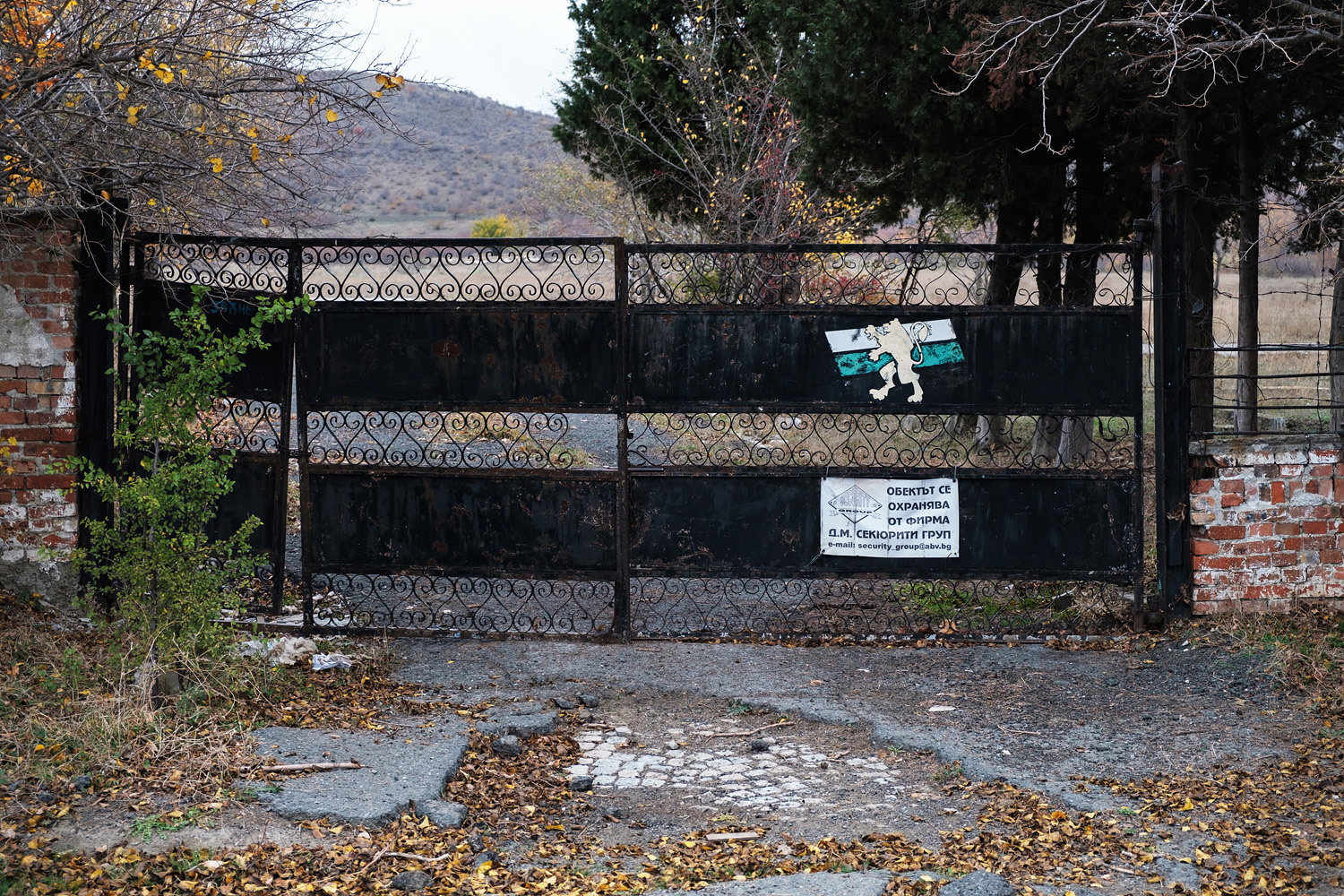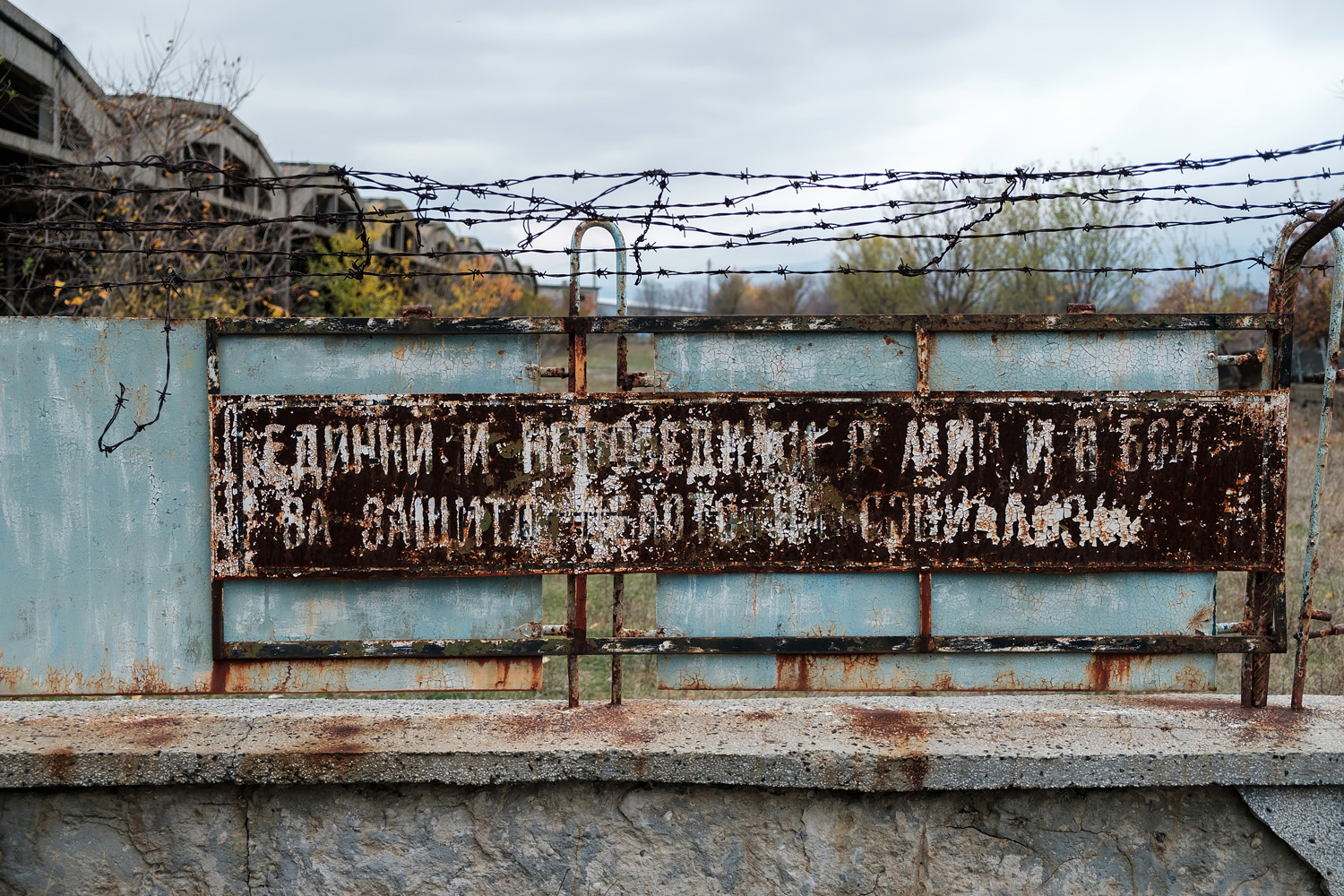 Whoever "they" are, they're not even pretending to guard this place anymore. Down the road bank, under the decrepit, asphalted surface of the road to Karageorgievo and through the opening in the fence. That's all it takes to enter the realm of the once forbidden. Shepherds do it all the time to graze their cattle on the abundance of grass now covering the abandoned land.
Whoever "they" are, they're not even pretending to guard this place anymore. Down the road bank, under the decrepit, asphalted surface of the road to Karageorgievo and through the opening in the fence. That's all it takes to enter the realm of the once forbidden. Shepherds do it all the time to graze their cattle on the abundance of grass now covering the abandoned land.
To my right, across the overgrowth and past the adjacent fence - a car. Then, a familiar sound - someone is mowing the grass in the main compound - the only place that still sees the occasional human presence. Slightly crouching in a half-hearted attempt not to be noticed (though I hardly think it would make a difference), I move across the field, camera in hand, into the small building in front of me.
A little over a year later, I am once again back inside the confines of the ex-military grounds in Aytos.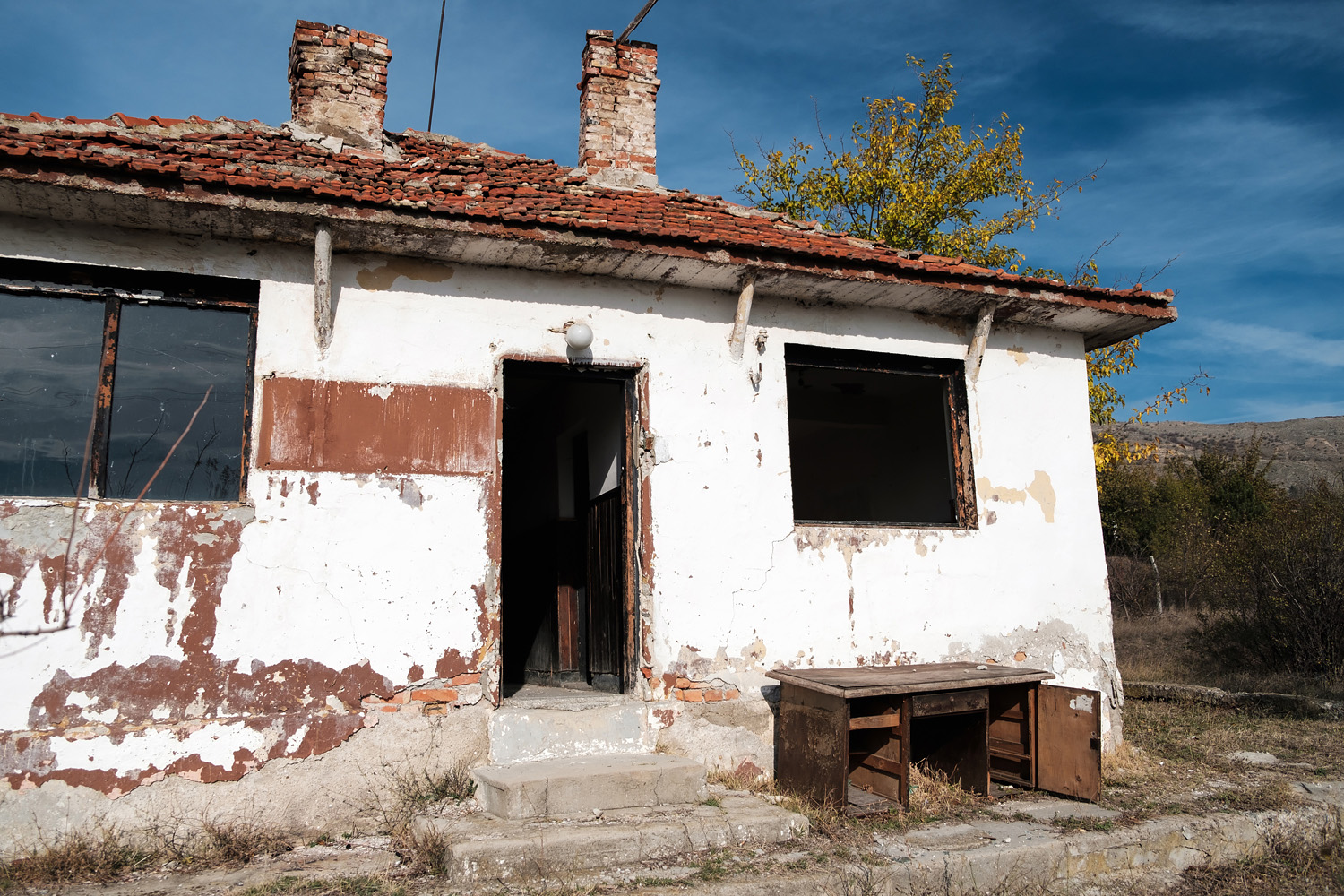 For many years, wild rumors circulated around the city, that NATO was intent on using the old tank brigade compound to establish a base. The speculations, however, never materialized into action - the grounds continued to sink into oblivion. Perhaps it was all just another way to maintain the illusion that the city would finally take measures to deal with the enormous open space that had been sitting unused for decades. At present day, all that the grounds have to offer is more and more ruins. It was just a matter of what type of decay I would find in this particular wing of the base. As I entered the small shack that looked nothing more pretentious than the ubiquitous Bulgarian multi-purpose building, I veered left into the first compartment.
For many years, wild rumors circulated around the city, that NATO was intent on using the old tank brigade compound to establish a base. The speculations, however, never materialized into action - the grounds continued to sink into oblivion. Perhaps it was all just another way to maintain the illusion that the city would finally take measures to deal with the enormous open space that had been sitting unused for decades. At present day, all that the grounds have to offer is more and more ruins. It was just a matter of what type of decay I would find in this particular wing of the base. As I entered the small shack that looked nothing more pretentious than the ubiquitous Bulgarian multi-purpose building, I veered left into the first compartment.
Remains on the wall testified to a pipe stove that was once here. It must have been necessary to guard against the piercing autumn winds sweeping through the open field and the winter snows that cover the Aytos plains on occasion. From experience, I know that the shabby construction and poor insulation of this type of building demand it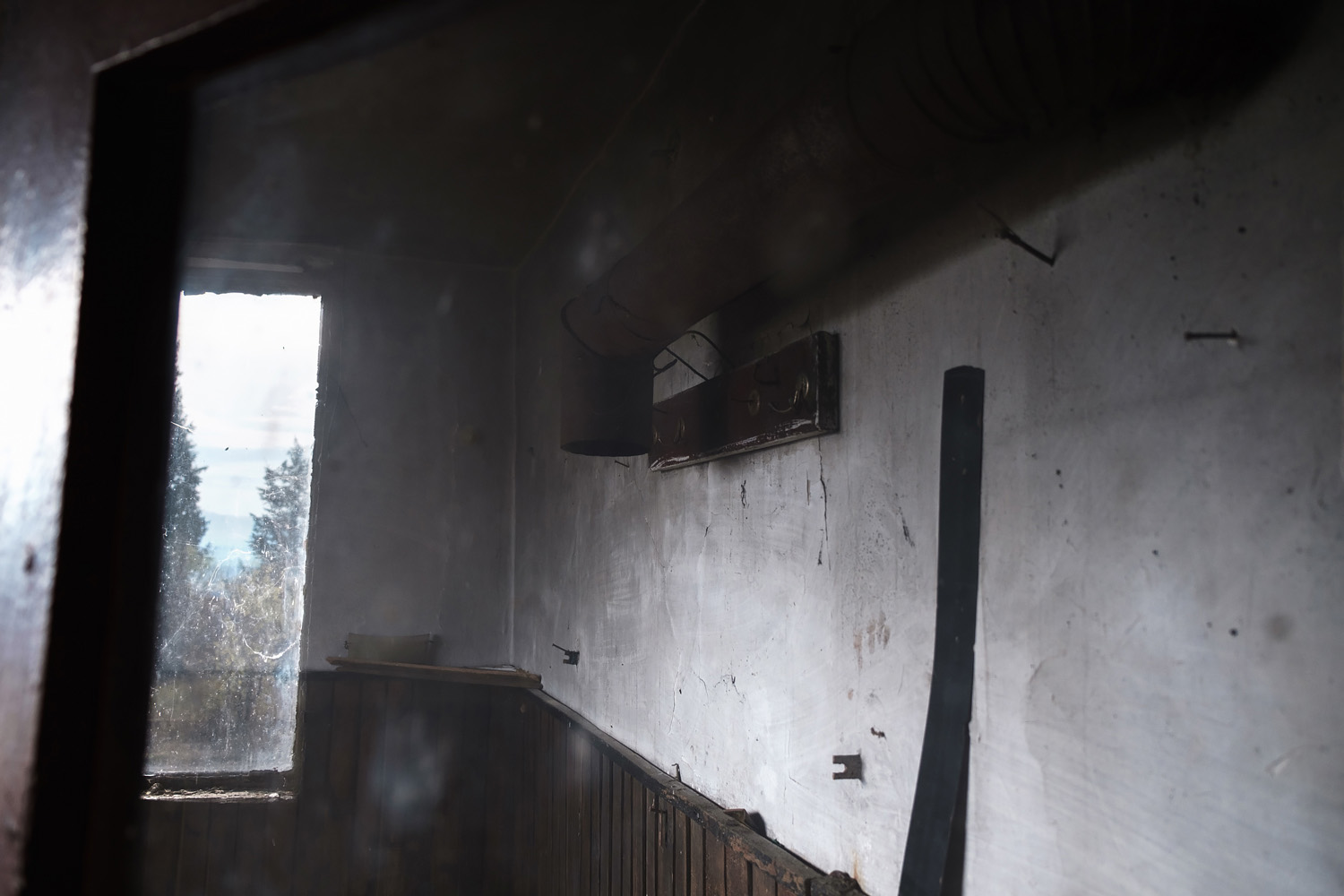 Turning toward the direction of the road, I saw my reflection gazing back at me from a faded and jagged mirror. An adjacent pair of dead reading glasses added to the apocalyptic scene.
Turning toward the direction of the road, I saw my reflection gazing back at me from a faded and jagged mirror. An adjacent pair of dead reading glasses added to the apocalyptic scene.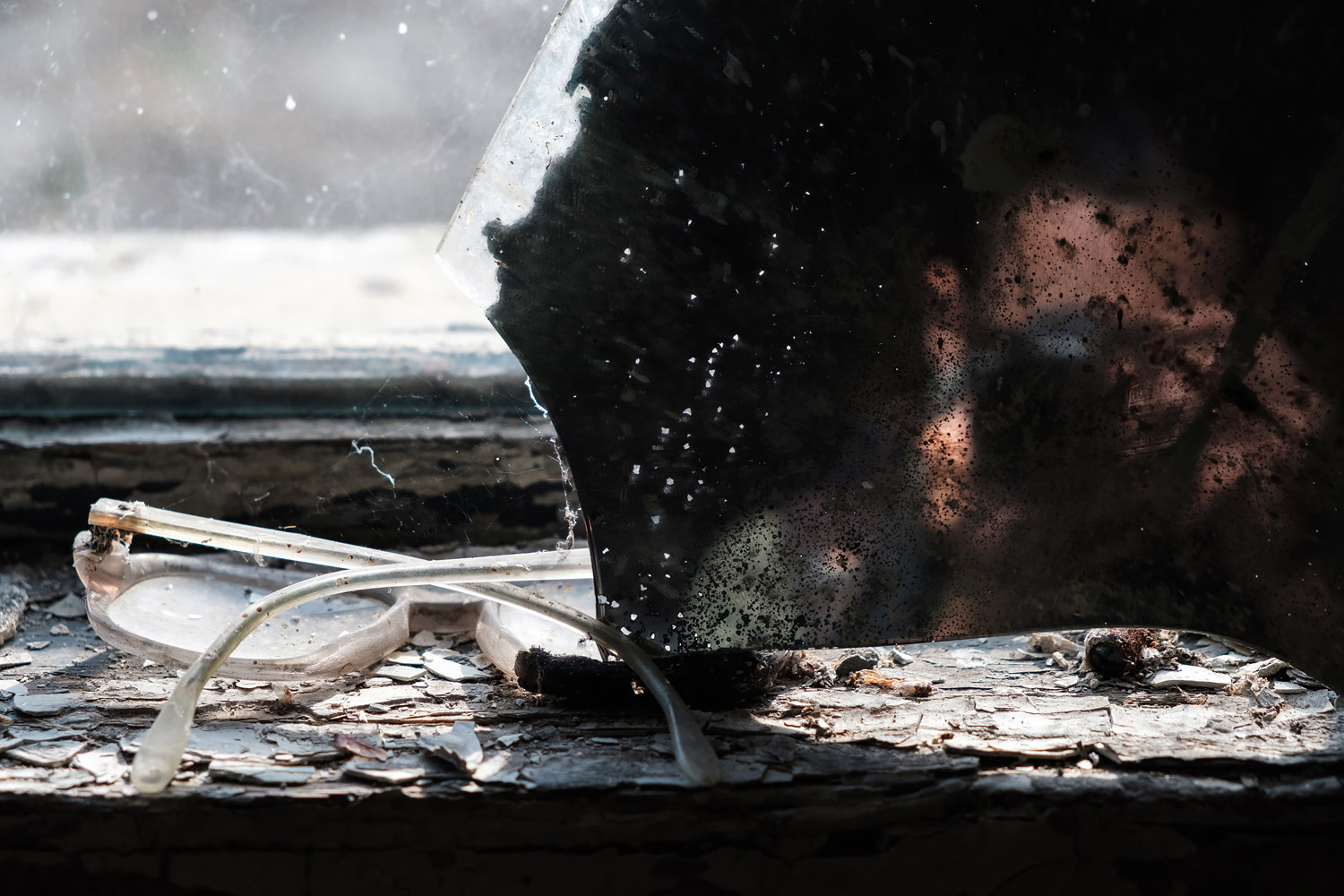 And even in this tiniest of rooms, all around me showed quiet scenes of chaos and destruction, rent from the once living fabric of the not-so-distant past.
And even in this tiniest of rooms, all around me showed quiet scenes of chaos and destruction, rent from the once living fabric of the not-so-distant past. 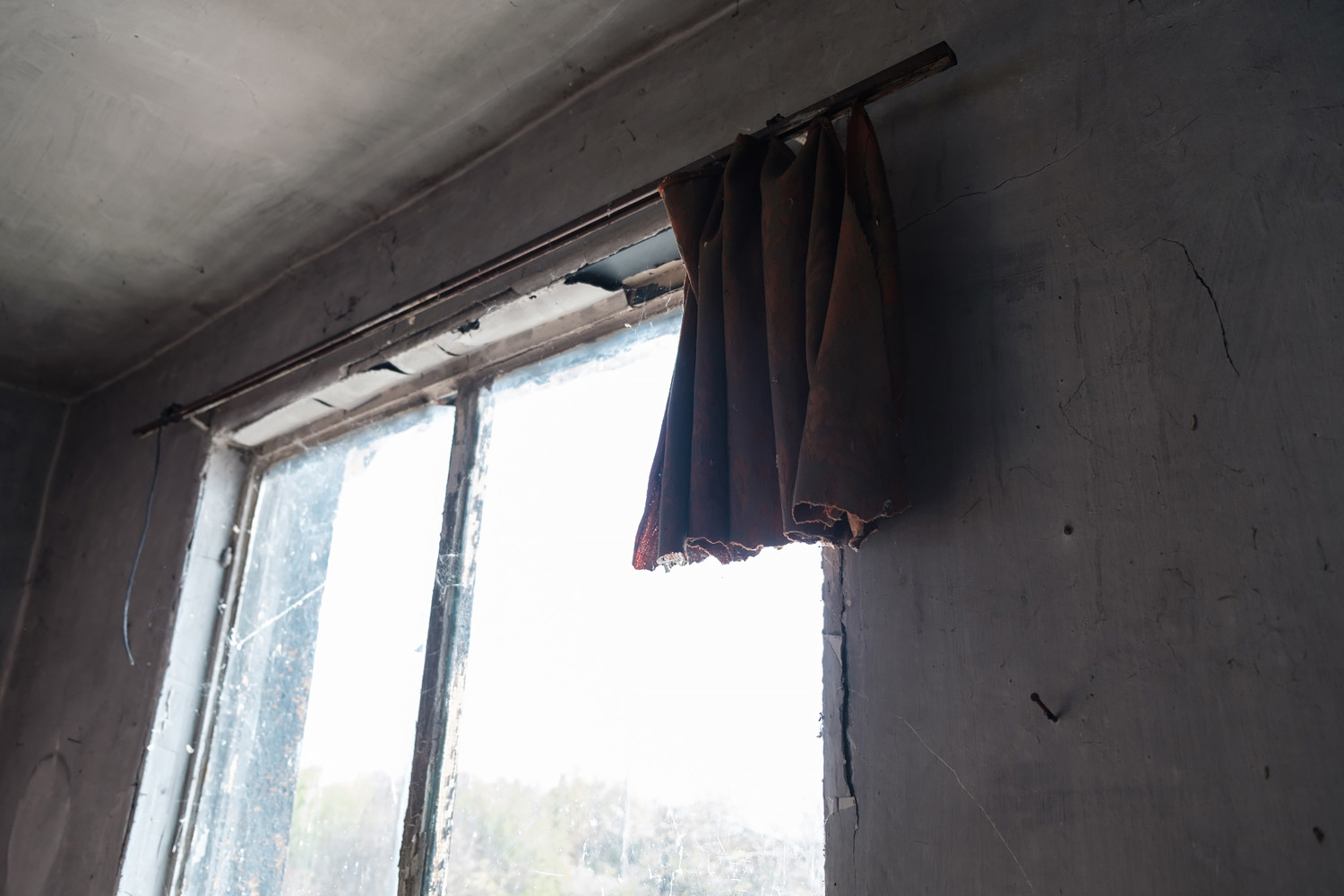
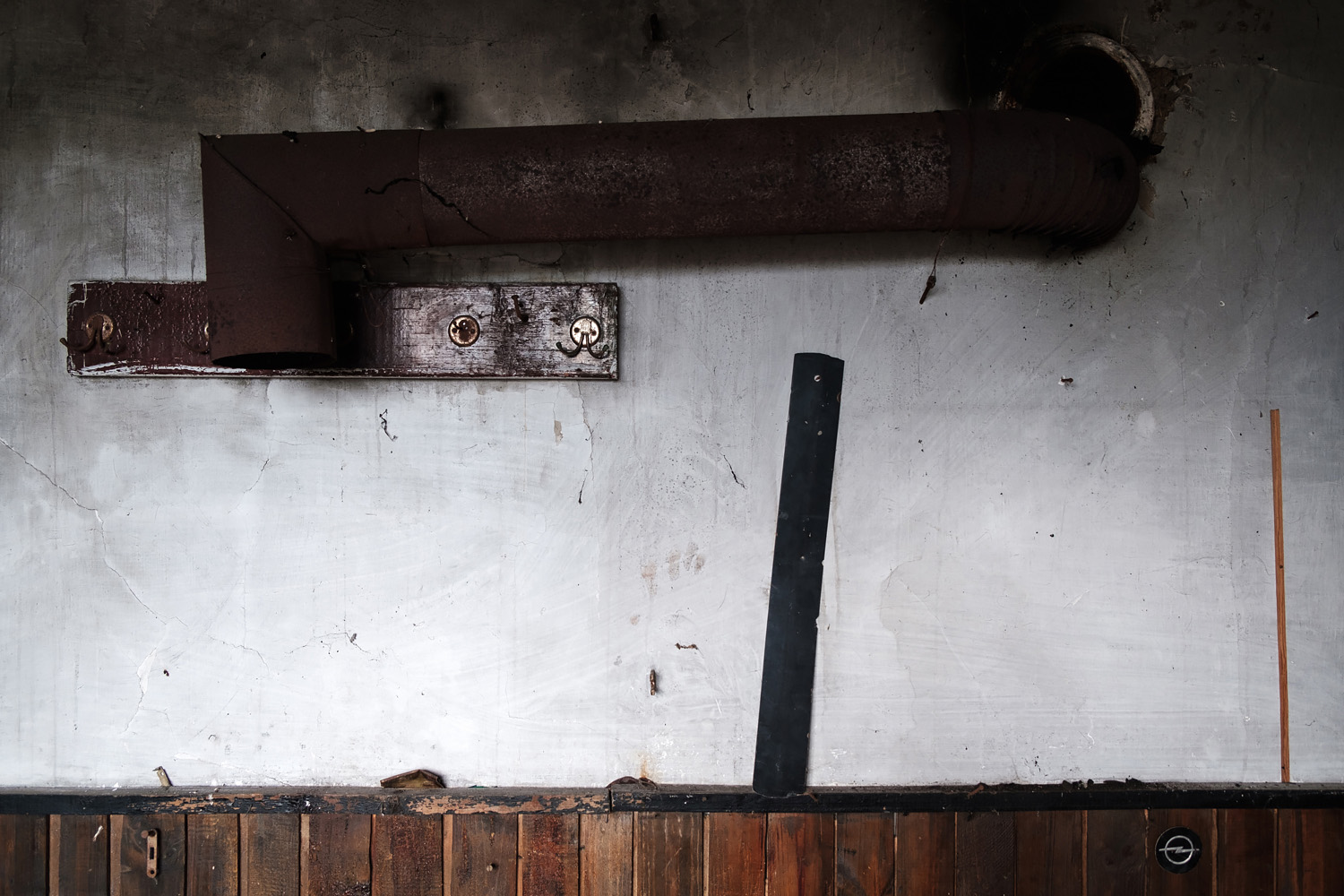 I came back to the small hallway, and navigated to room number two, where wild colors and even wilder decay reigned.
I came back to the small hallway, and navigated to room number two, where wild colors and even wilder decay reigned. 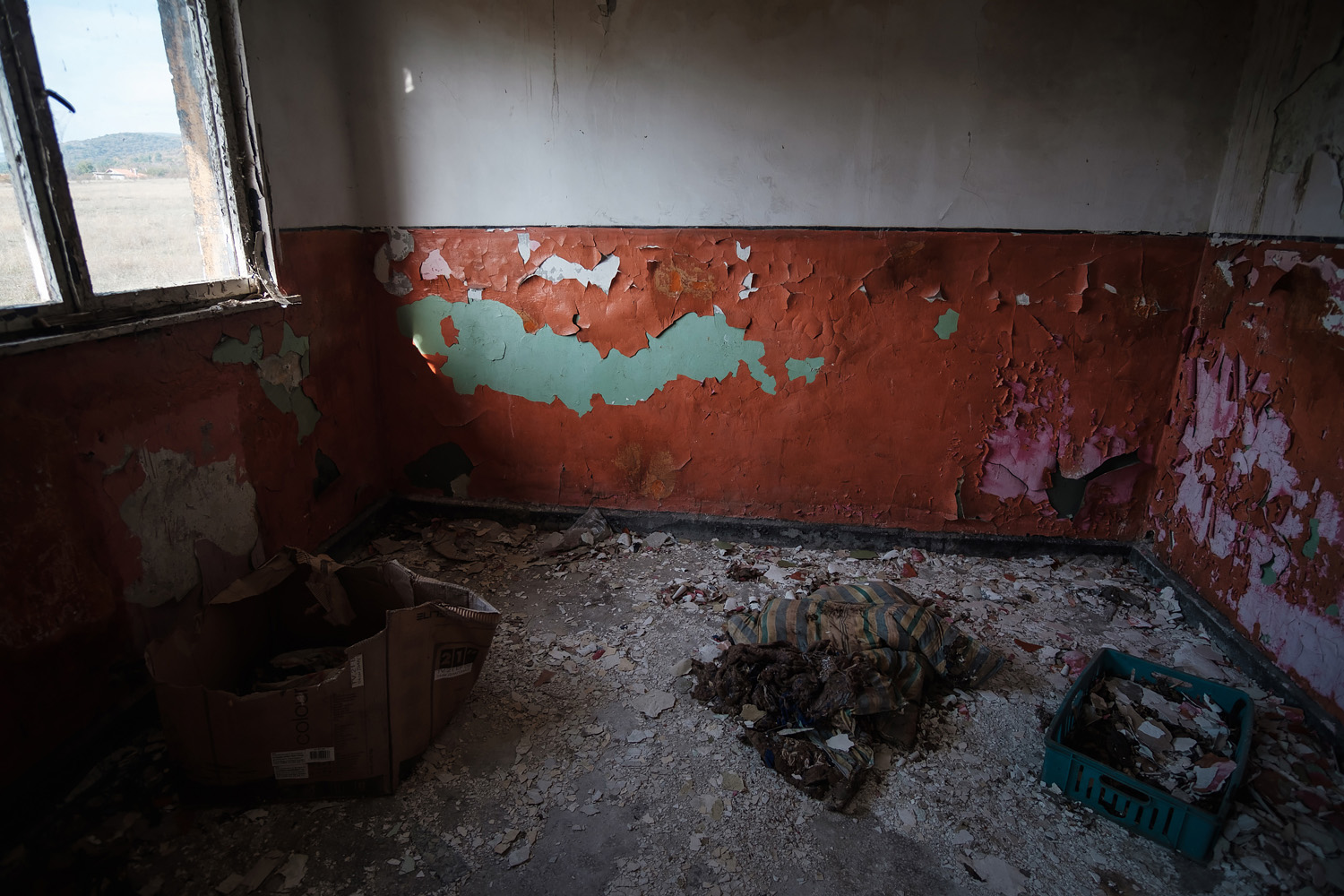
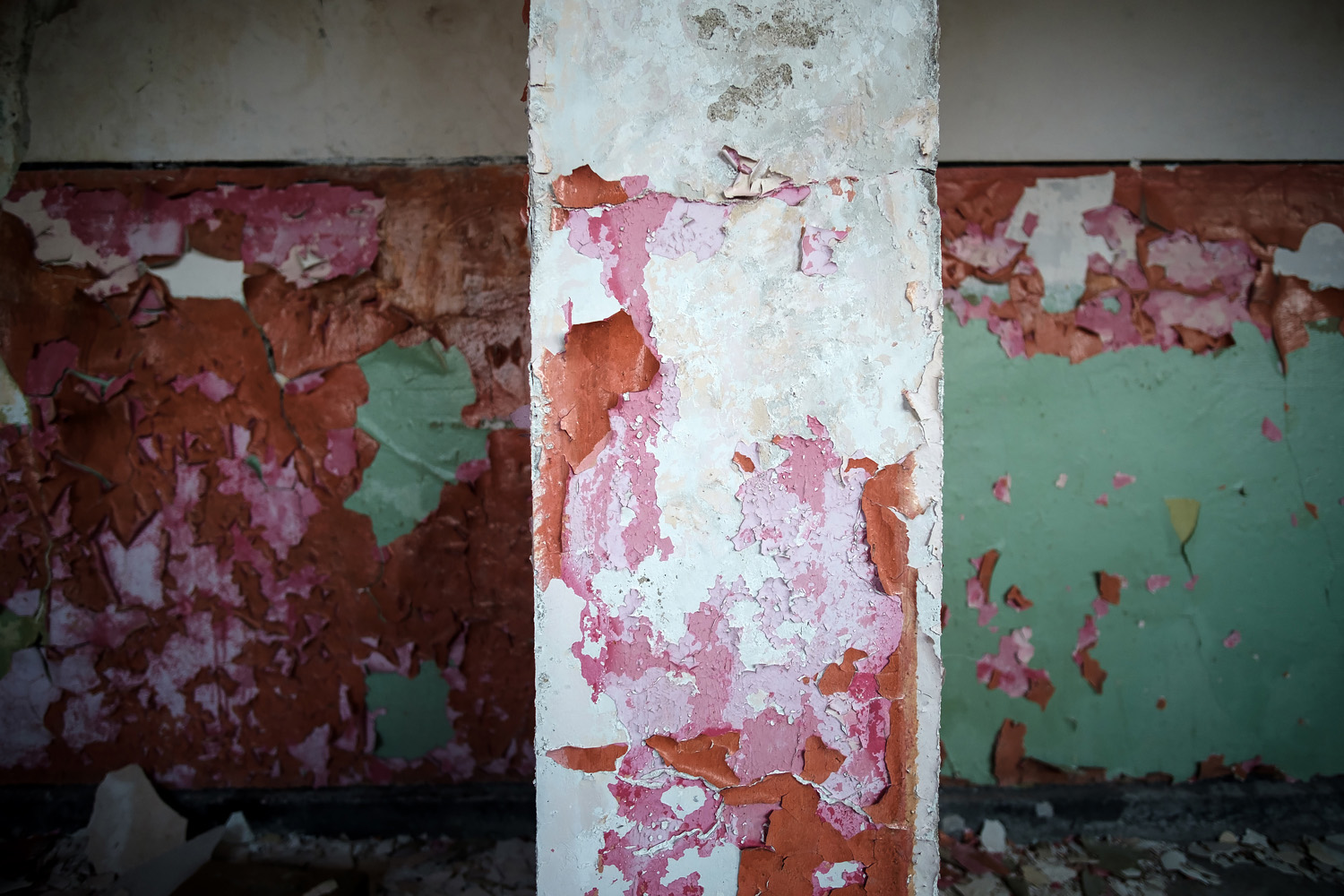 It seemed that the walls of this room had changed garb many times, perhaps to suit political or higher-command whims. But as colorful as the multiple layers of paint, now all exposed, were, there was nothing much to see here.
It seemed that the walls of this room had changed garb many times, perhaps to suit political or higher-command whims. But as colorful as the multiple layers of paint, now all exposed, were, there was nothing much to see here.
The blue-hued room across the small hallway seemed to be enamored with more charm and substance. The variety of color on display, and specifically the different paint scheme featured in every space in this building I found definitely unusual. But I remembered seeing a similar lack of decorative uniformity in the 24th Tank Brigade's quarters inside the main city compound during our 2016 visit, and deduced that maybe I was witnessing a strange recurring pattern. A tiled sink that looked not only out of harmony with its surrounding colors but also of strangely recent construction, greeted me on the way in: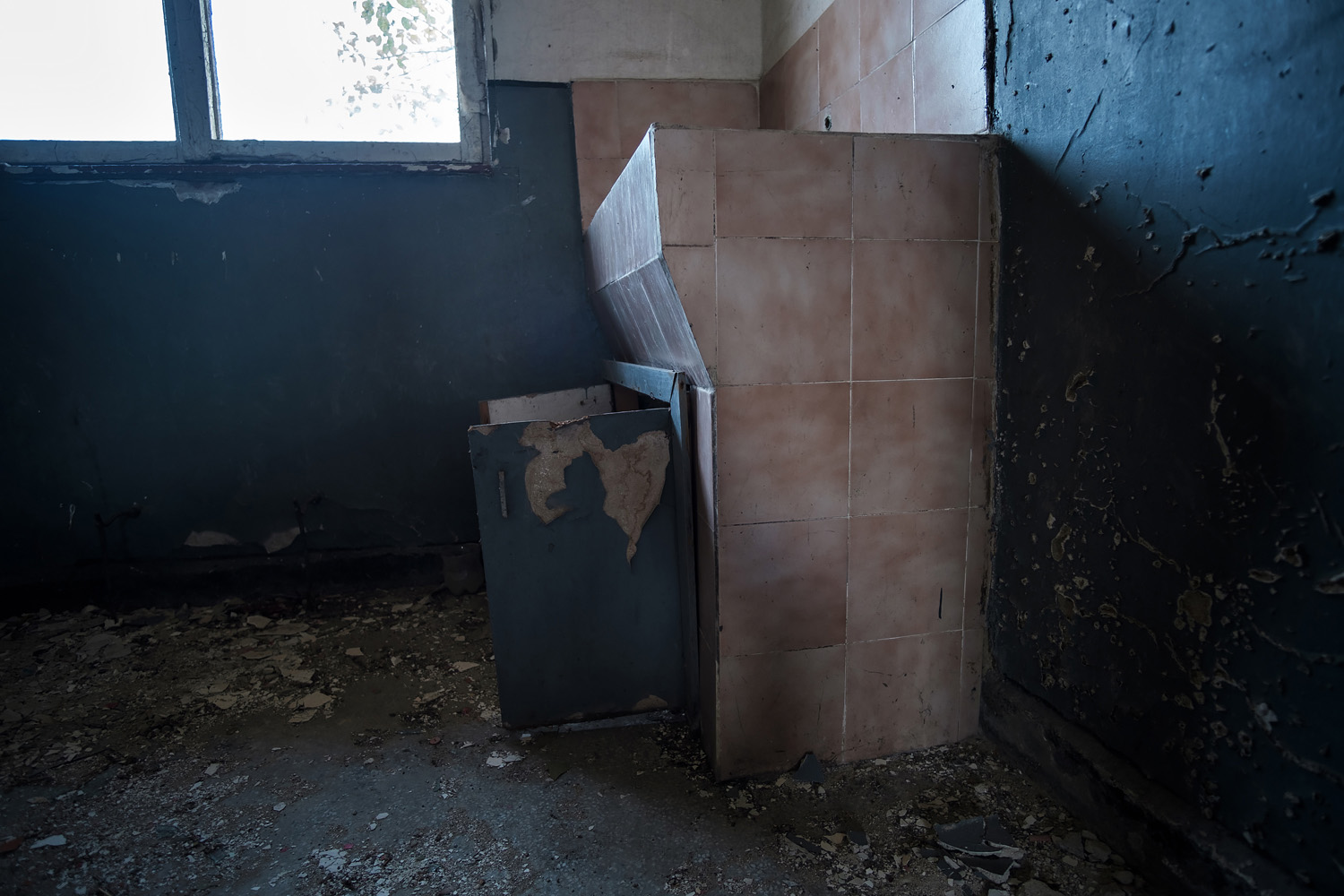 My excitement over the discovery of what seemed like old medicine bottles diminished only slightly upon finding out they were actually once an oil and vinegar set:
My excitement over the discovery of what seemed like old medicine bottles diminished only slightly upon finding out they were actually once an oil and vinegar set: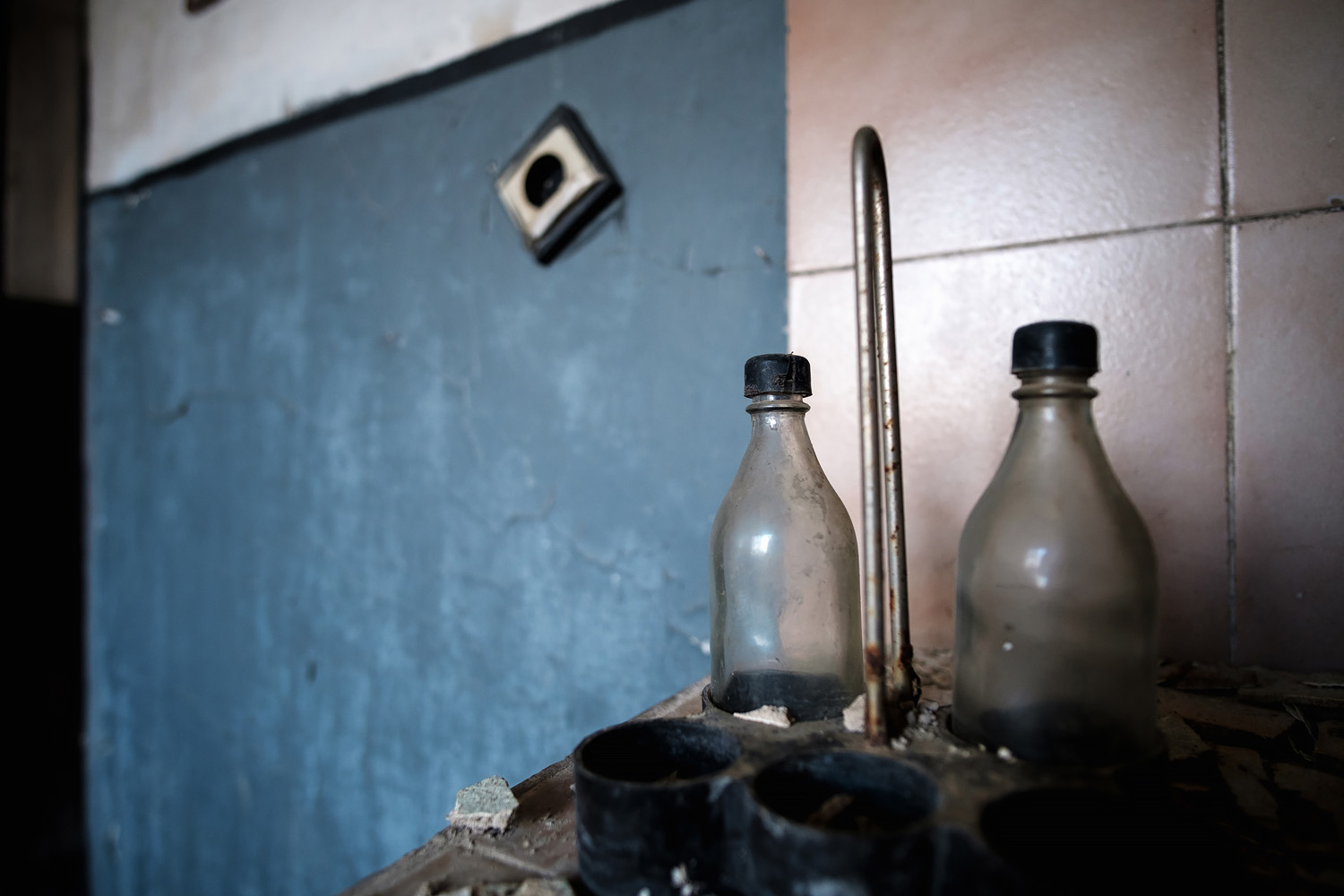 I did appreciate dramatic look of the wall opposite, artistically veiled in half-shadow and adorned by the strategic placement of a lonely towel. Found aesthetic and scenes of apocalyptic art are hard to resist:
I did appreciate dramatic look of the wall opposite, artistically veiled in half-shadow and adorned by the strategic placement of a lonely towel. Found aesthetic and scenes of apocalyptic art are hard to resist: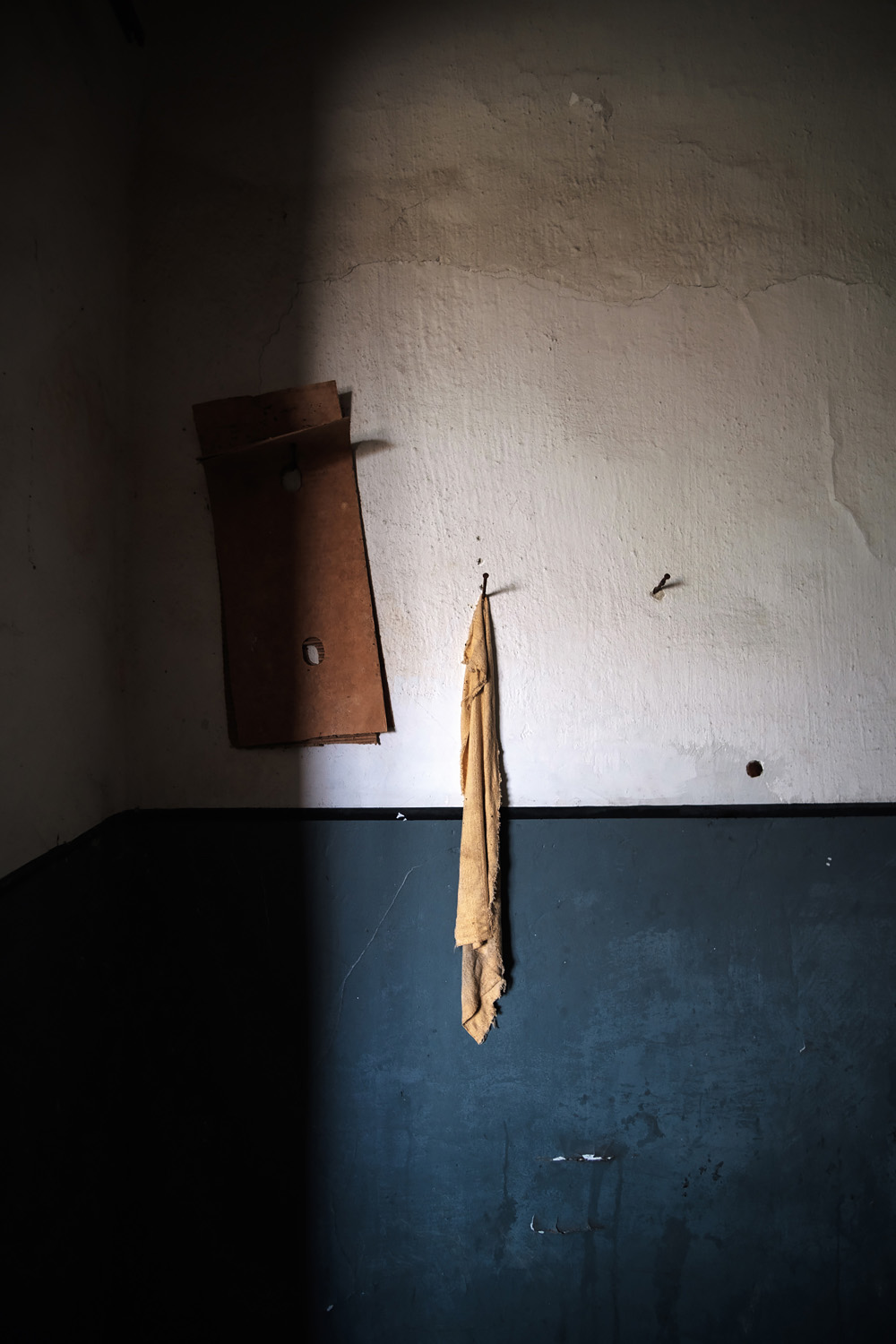 And yet another color combination on the way out - a maimed door with a fresh-looking coat of dark brown paint to bid me farewell:
And yet another color combination on the way out - a maimed door with a fresh-looking coat of dark brown paint to bid me farewell: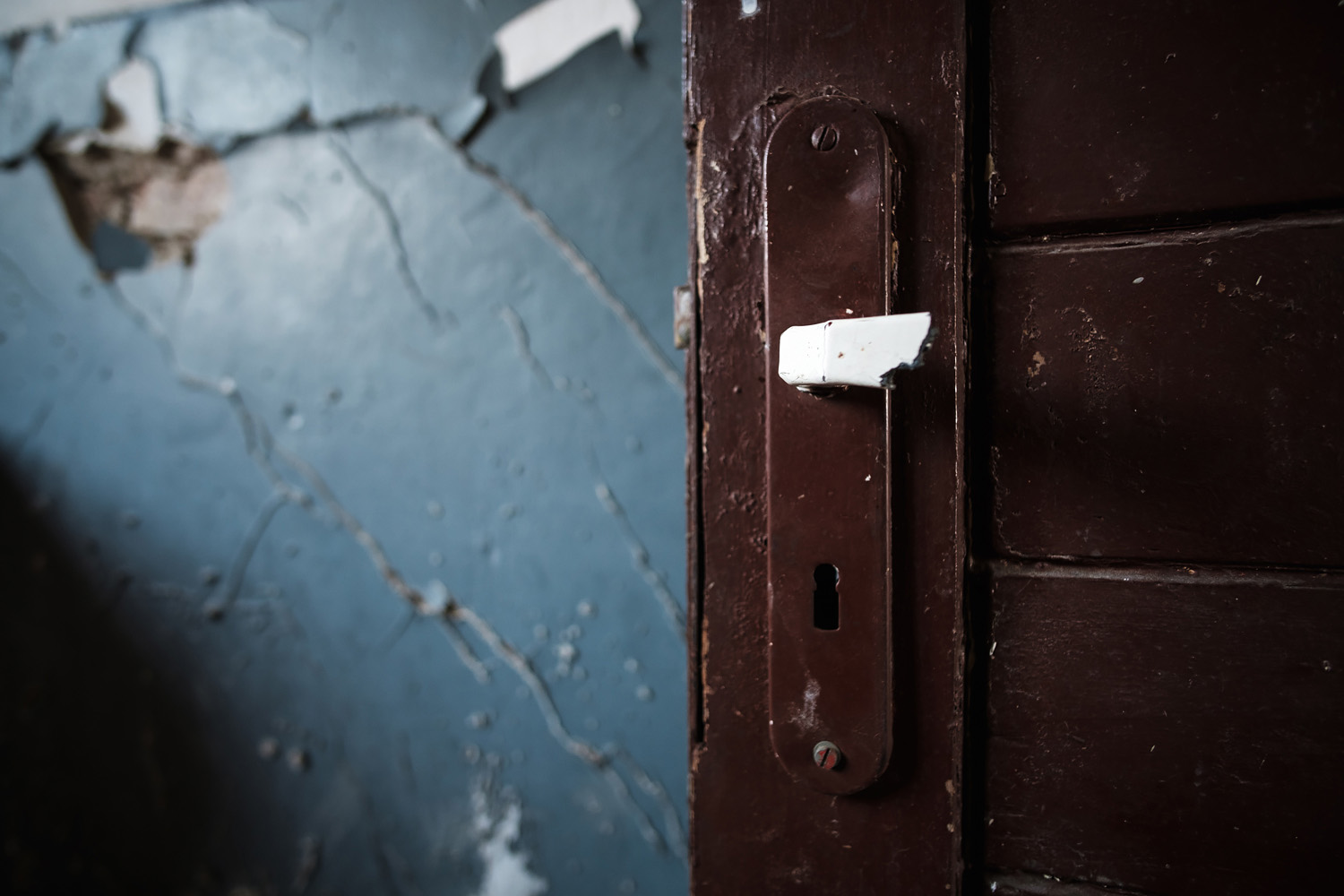 As I exited, I immediately found where the missing stove from room one was now living. The light stream from the long-gone main entrance door was bathing its dark corner in dramatic shadow:
As I exited, I immediately found where the missing stove from room one was now living. The light stream from the long-gone main entrance door was bathing its dark corner in dramatic shadow: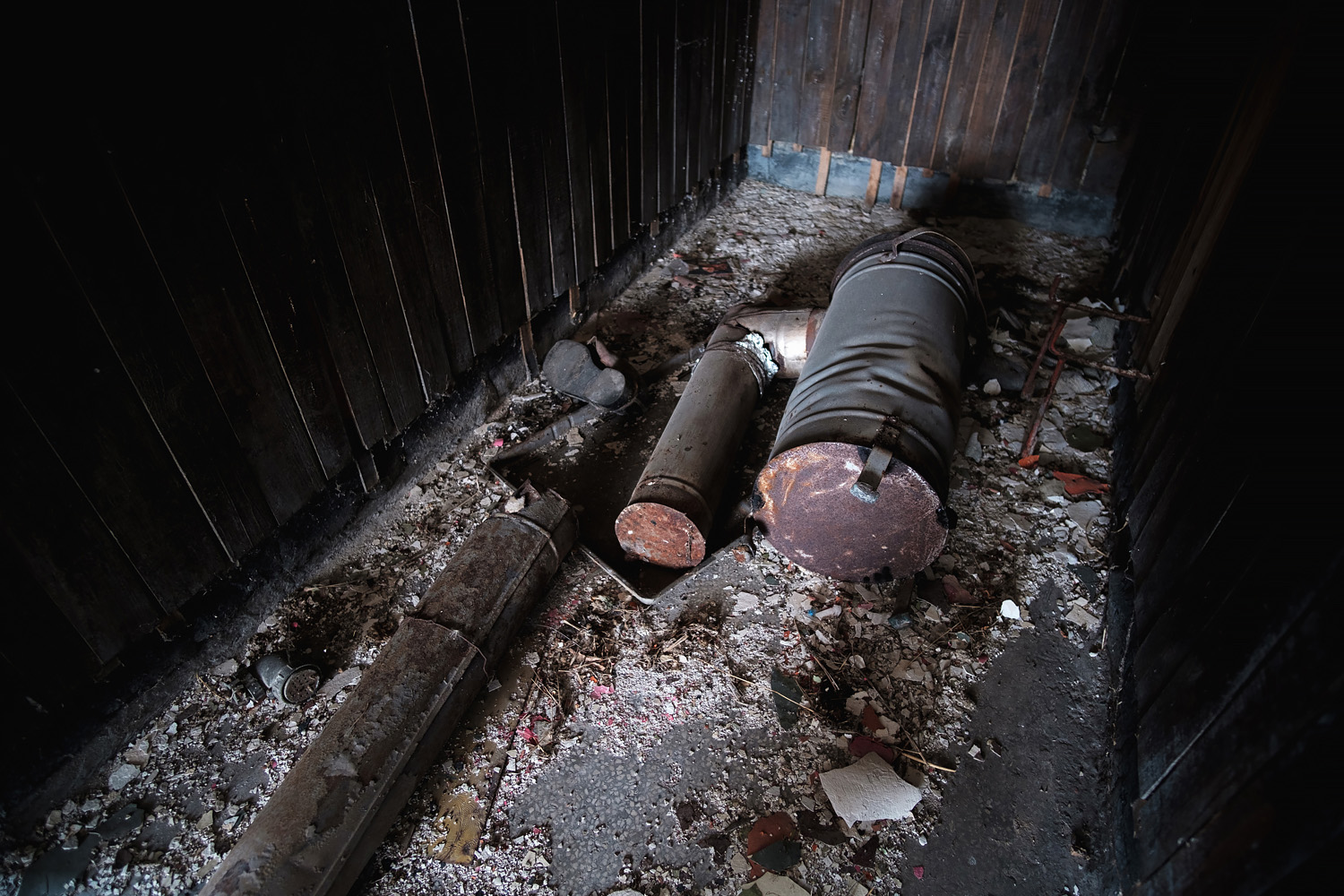 Traces of the stove's once fulfilling life was what I first glanced upon my entrance, and coming full circle, it was now sending me on my way as I exited the small building. This strange contraption was planted right in front of the main entrance - I had no clues as to its purpose:
Traces of the stove's once fulfilling life was what I first glanced upon my entrance, and coming full circle, it was now sending me on my way as I exited the small building. This strange contraption was planted right in front of the main entrance - I had no clues as to its purpose: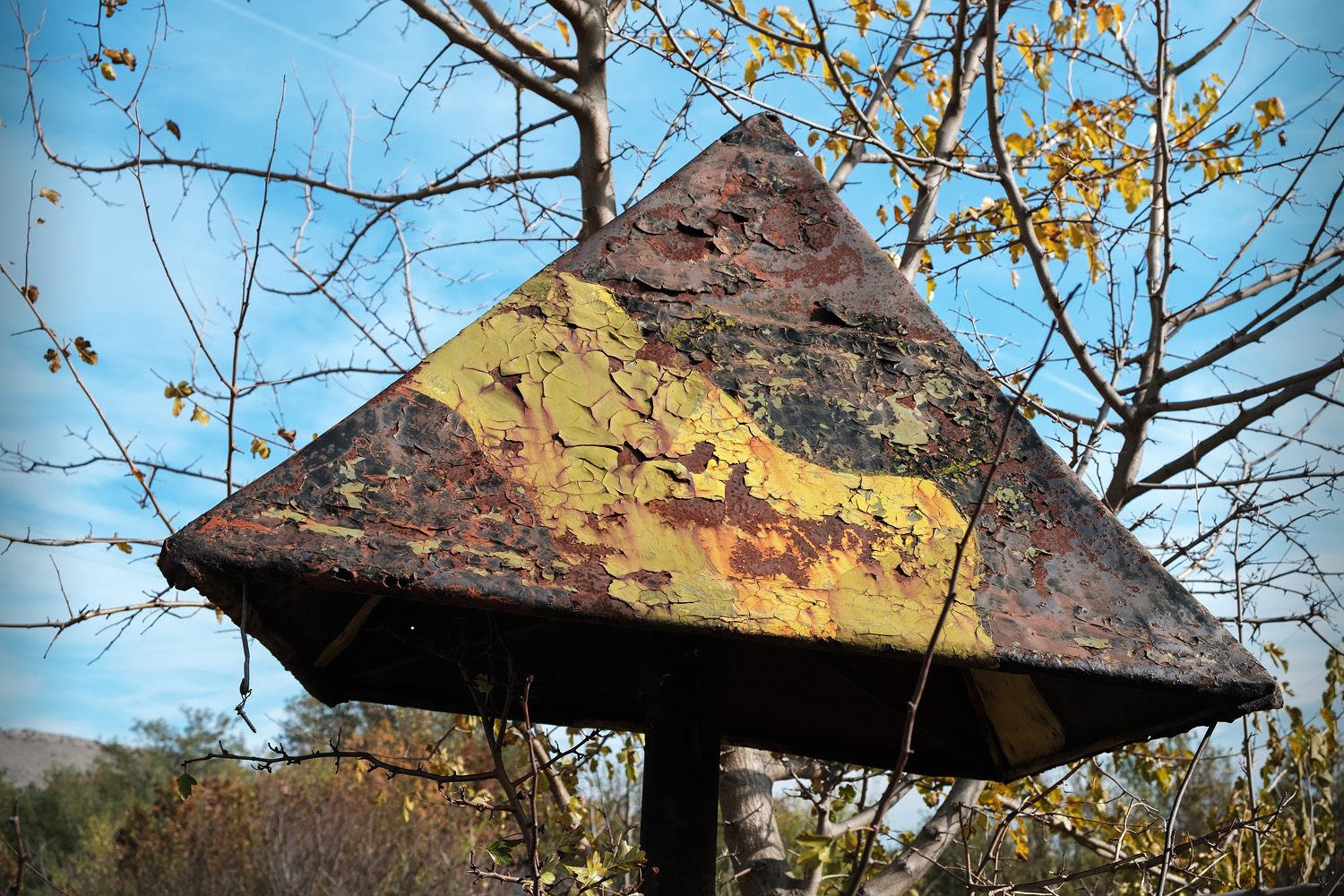 No one seemed to be around on this fine autumn day, and I thought I'd try to take a walk inside the perimeter. Heading west across the vast field parallel to the road, it wasn't long before I was able to see into the main compound just next door - and next on the list for exploration:
No one seemed to be around on this fine autumn day, and I thought I'd try to take a walk inside the perimeter. Heading west across the vast field parallel to the road, it wasn't long before I was able to see into the main compound just next door - and next on the list for exploration: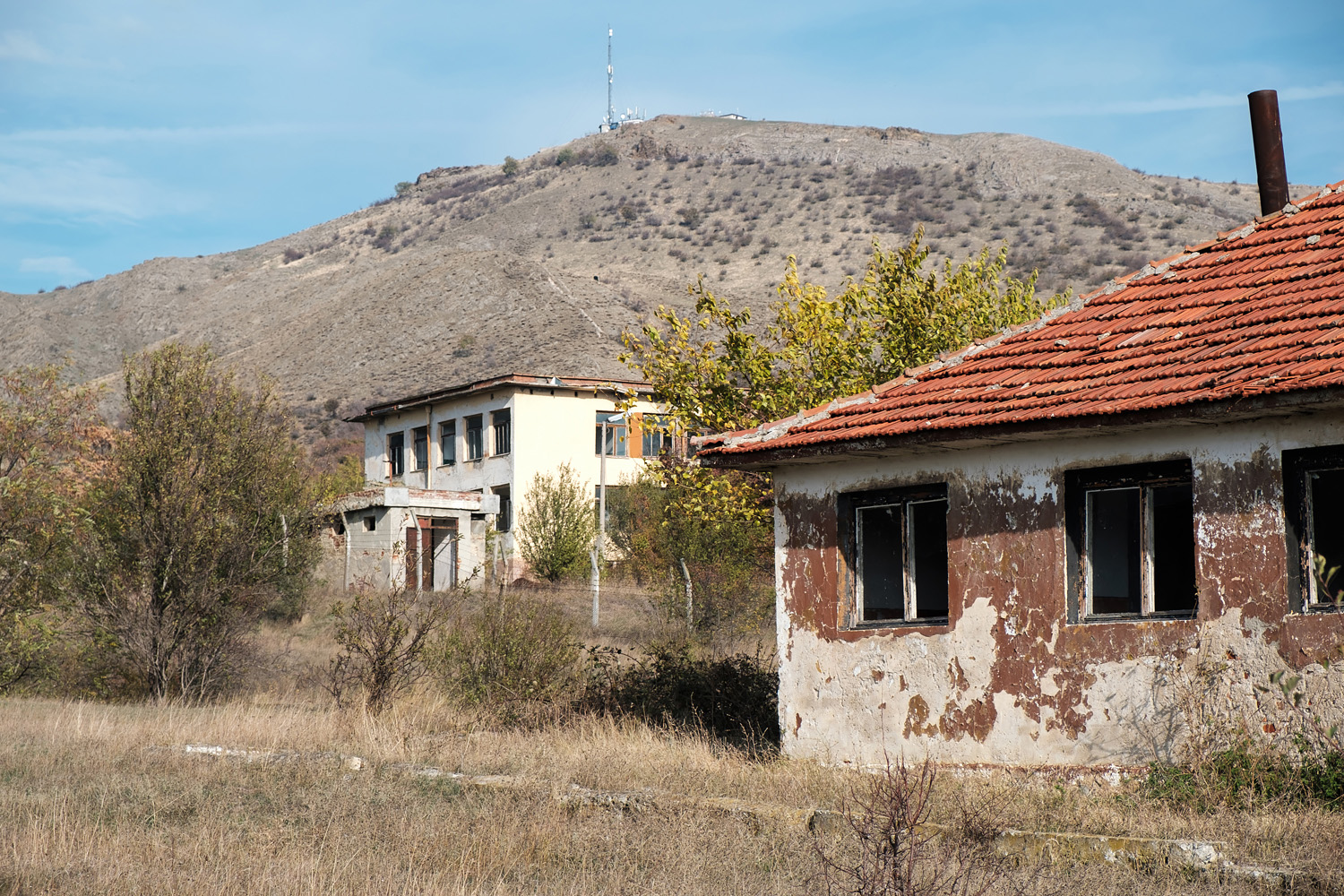 As I continued across the field, an unfriendly-looking and sounding dog appeared out of the ruins, thus managing to cut short my wanderings in this particular spot. Not wanting to draw attention to my presence or contend with the animal, I headed back to my original point of entry and headed out.
As I continued across the field, an unfriendly-looking and sounding dog appeared out of the ruins, thus managing to cut short my wanderings in this particular spot. Not wanting to draw attention to my presence or contend with the animal, I headed back to my original point of entry and headed out.
I crouched into the small tunnel under the asphalted main road and proceeded to the fields next to the railroad tracks. An interesting fact about the former military installation in Aytos is that it was of gargantuan proportions, definitely so when compared to the relatively small town it existed in. In addition to the main post next door and the enormous barracks and exercise grounds of the 24th Tank Brigade inside the town iteslf, the fields adjacent to the road leading from Aytos to Karageorgievo also held training grounds, obstacles, trenches and various contraptions. Much remains of these installations even today, and I thought I'd take a look, since the inside of the complex had proved temporarily unfriendly to a random visitor like me.
It wasn't long before a gathering of tank obstacles appeared out of the overgrowth: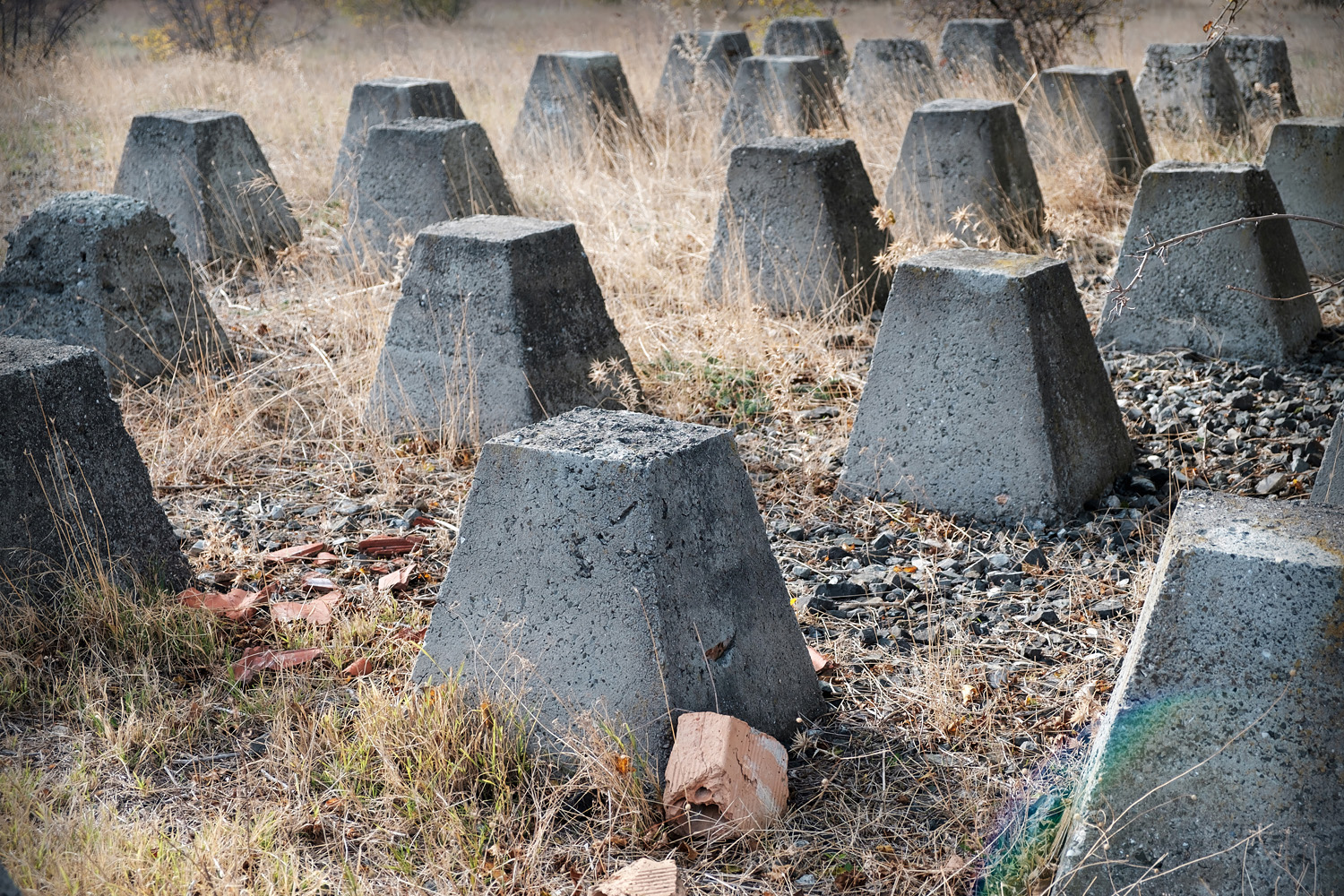 Next to the ranks of stone, an entrance to a trench complex, long forgotten and now unceremoniously inhabited by leafy occupants:
Next to the ranks of stone, an entrance to a trench complex, long forgotten and now unceremoniously inhabited by leafy occupants: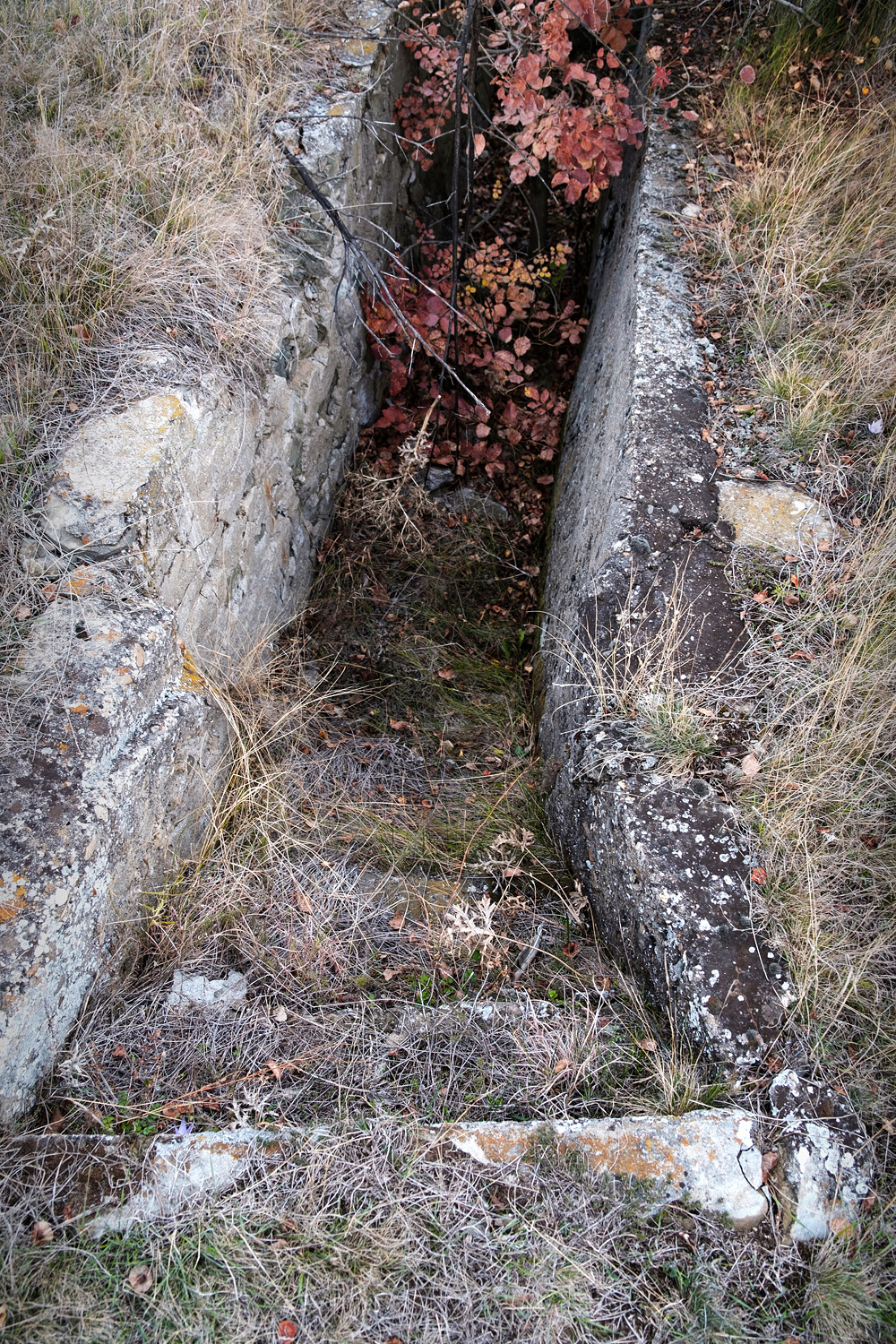 Once filled with soldiers, the training grounds were now empty. The autumn hues and dried up vegetation left an even somber impression of a place that was once vibrantly alive. A large concrete-lined open space added to the mystery, as I moved further down the tracks, walking back toward the city:
Once filled with soldiers, the training grounds were now empty. The autumn hues and dried up vegetation left an even somber impression of a place that was once vibrantly alive. A large concrete-lined open space added to the mystery, as I moved further down the tracks, walking back toward the city: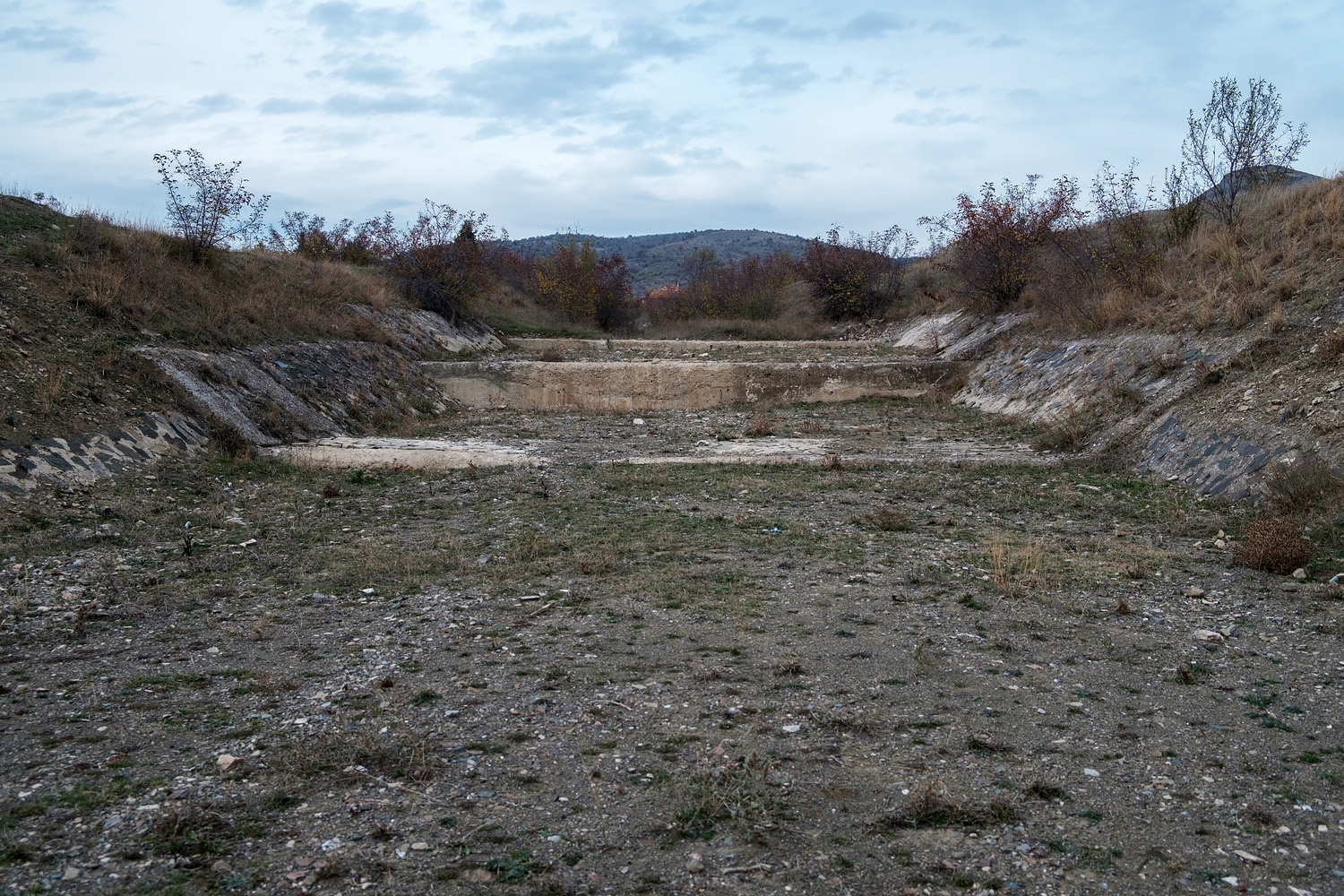 And finally, at this sad junction of decayed past and living present, a fitting visual commentary on the uneasy coexistence emerged from the grasses. I understood. The time had come to leave it all behind and head back home.
And finally, at this sad junction of decayed past and living present, a fitting visual commentary on the uneasy coexistence emerged from the grasses. I understood. The time had come to leave it all behind and head back home.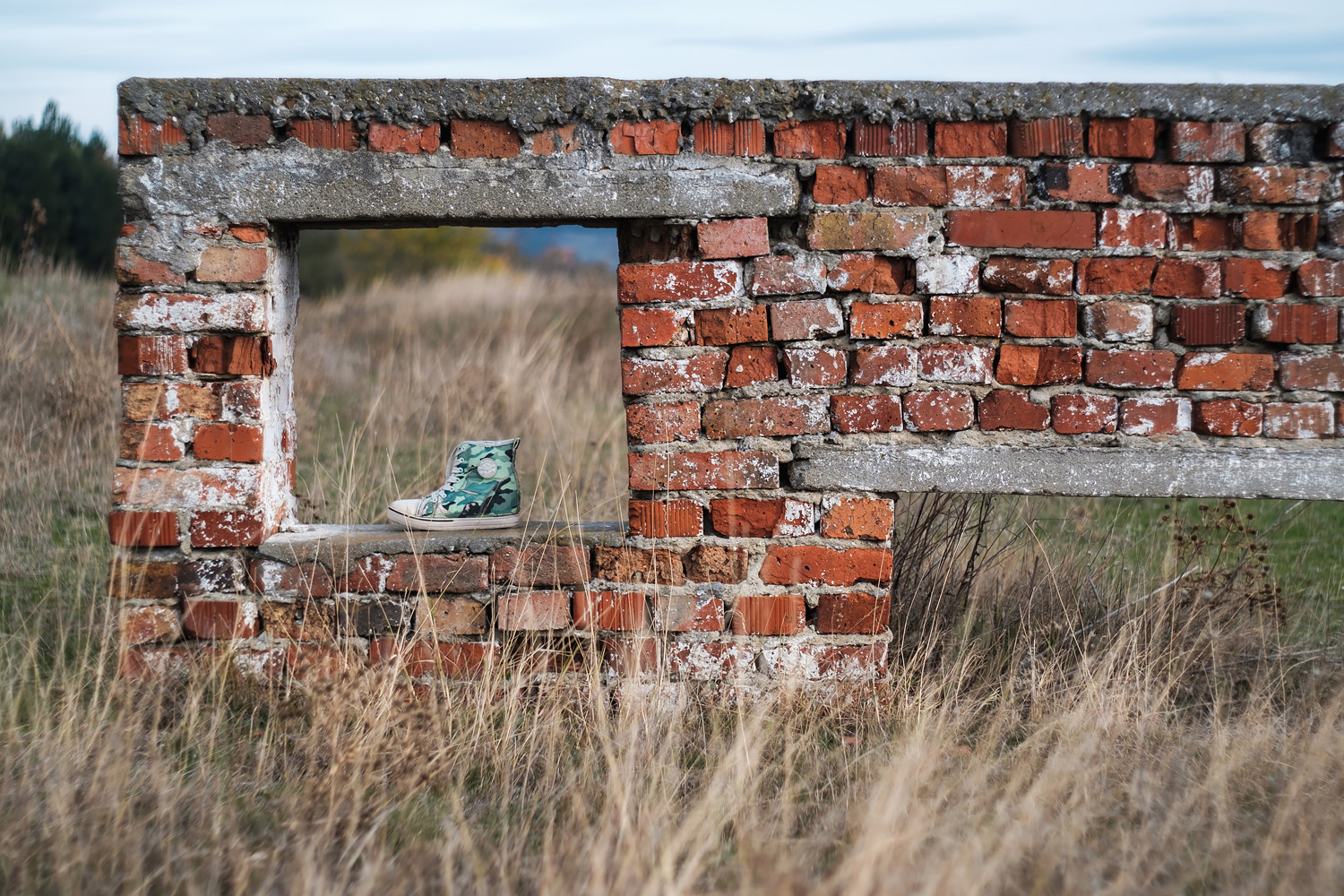
-----------------------------
It's another day and I am back where I started. Well, almost. This time, I decided to circle all the way around, behind the main post. I'm walking along the compound's barbed-wire fence and looking for any sign of a breach in the flimsy defenses. The trek had started out with a walk through the adjacent fields at the base of the Hisarya peak on the outskirts of Aytos, braving dung from cows, sheep the nearby gypsy camp's horses and the resulting invasion of flies. Once clear of the camp, I ascended the small hill that led to one of the main post's rear entrances. It once served both vehicles and personnel, but now, its decrepit state and the still-erect, camouflage-hued watchtower stood in sad silence, observing from afar the city they once helped guard. I must admit, the view toward the town was impressive, even on this overcast afternoon: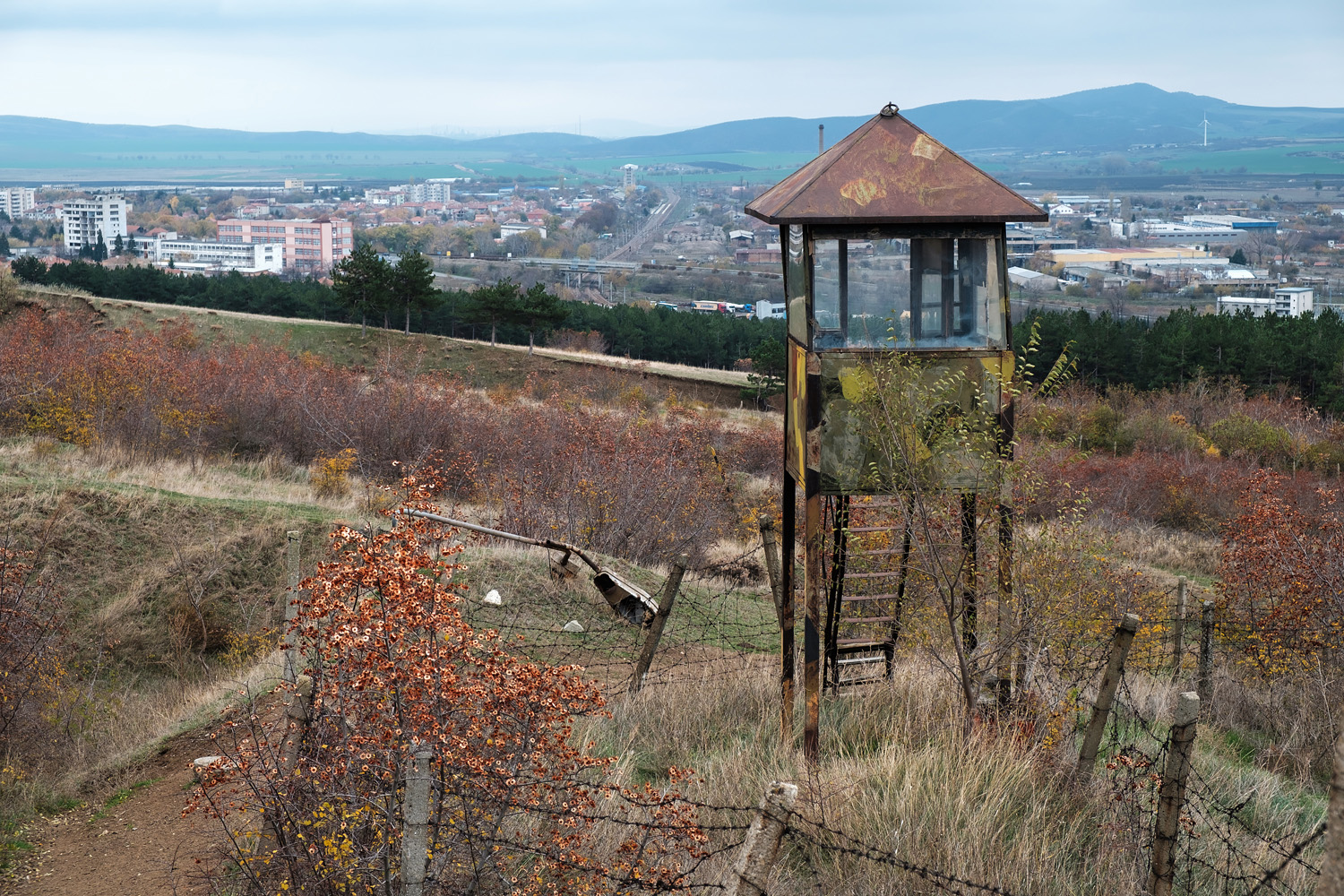 The fallen corpse of a once-functioning streetlight lay nearby:
The fallen corpse of a once-functioning streetlight lay nearby: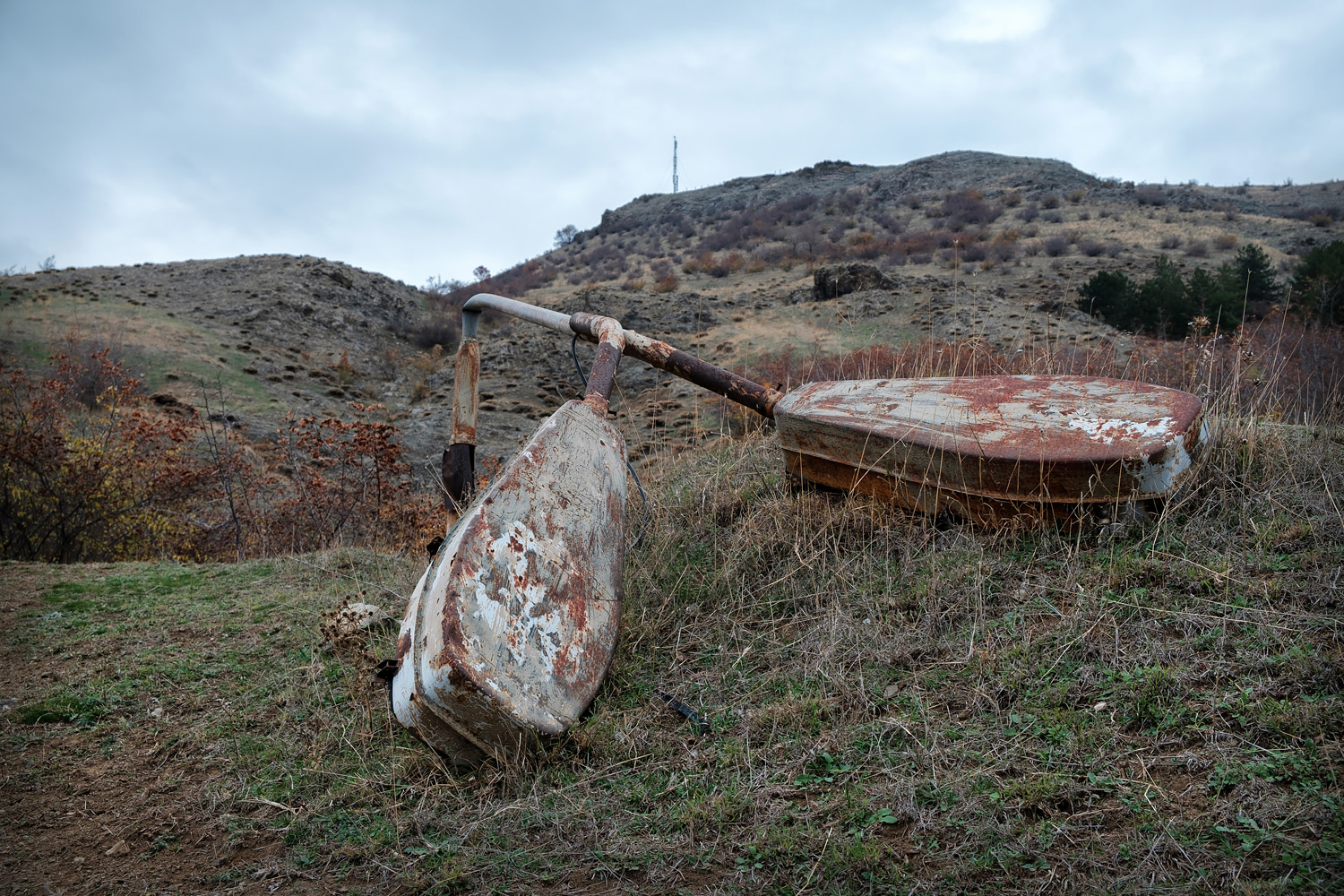 I continued my walk. There was not a soul in sight and I passed by the outer perimeter unperturbed:
I continued my walk. There was not a soul in sight and I passed by the outer perimeter unperturbed: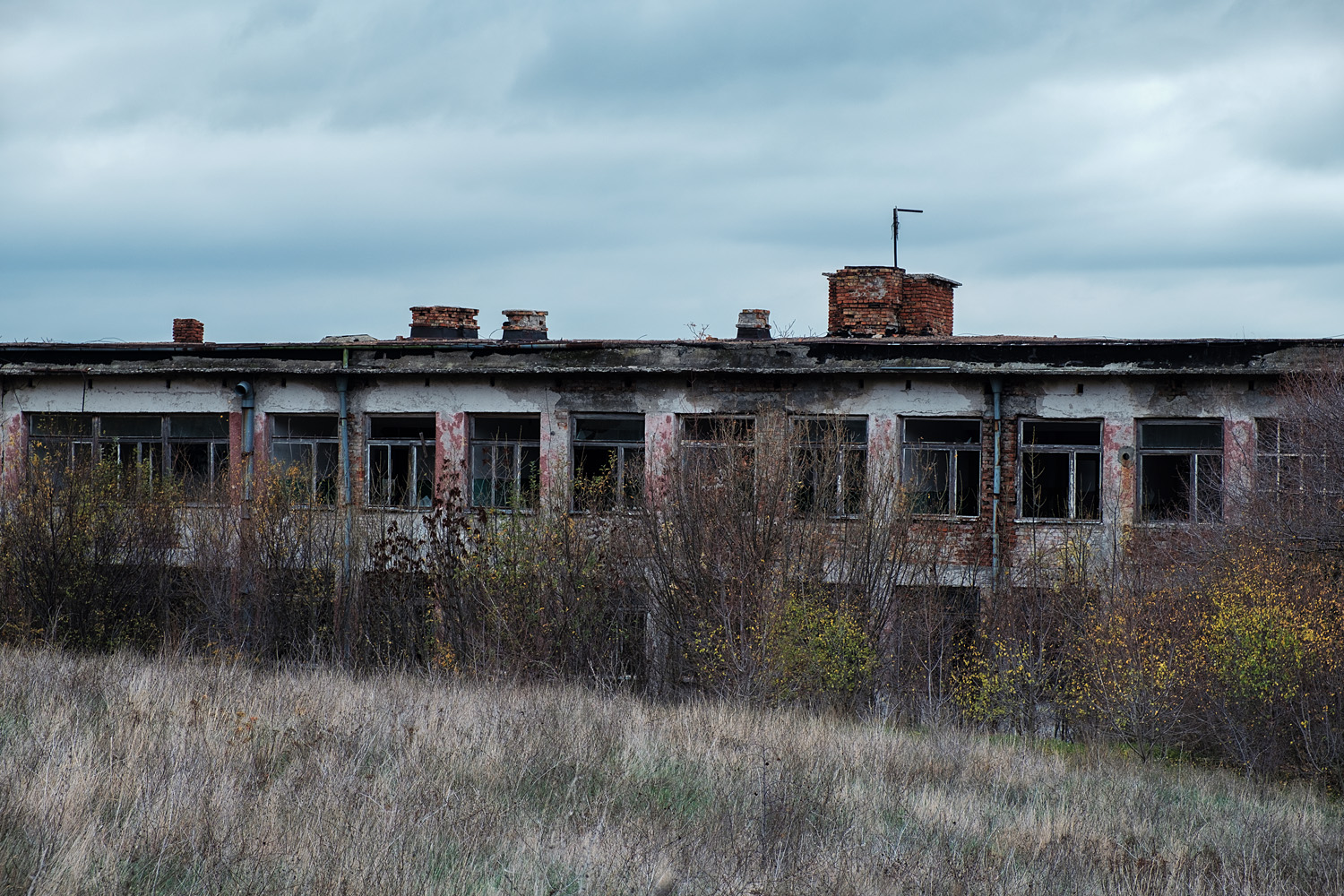 Aside from the gutted buildings, there was nothing much of interest either, and I could observe no suitable place for a possible entry. That, combined with the fact that I was alone, dissuaded me for trying to enter the compound itself. Instead, I thought I would walk all the way around, down the other side of the hill and see if I could explore the tank shooting range and garages that lay in close proximity to the main road and the building I had already visited. The walk down was not easy, as there was no clear path through the overgrown shrubs and it took me a while before I found myself on flat ground. Once I did, however, the destination soon revealed itself:
Aside from the gutted buildings, there was nothing much of interest either, and I could observe no suitable place for a possible entry. That, combined with the fact that I was alone, dissuaded me for trying to enter the compound itself. Instead, I thought I would walk all the way around, down the other side of the hill and see if I could explore the tank shooting range and garages that lay in close proximity to the main road and the building I had already visited. The walk down was not easy, as there was no clear path through the overgrown shrubs and it took me a while before I found myself on flat ground. Once I did, however, the destination soon revealed itself: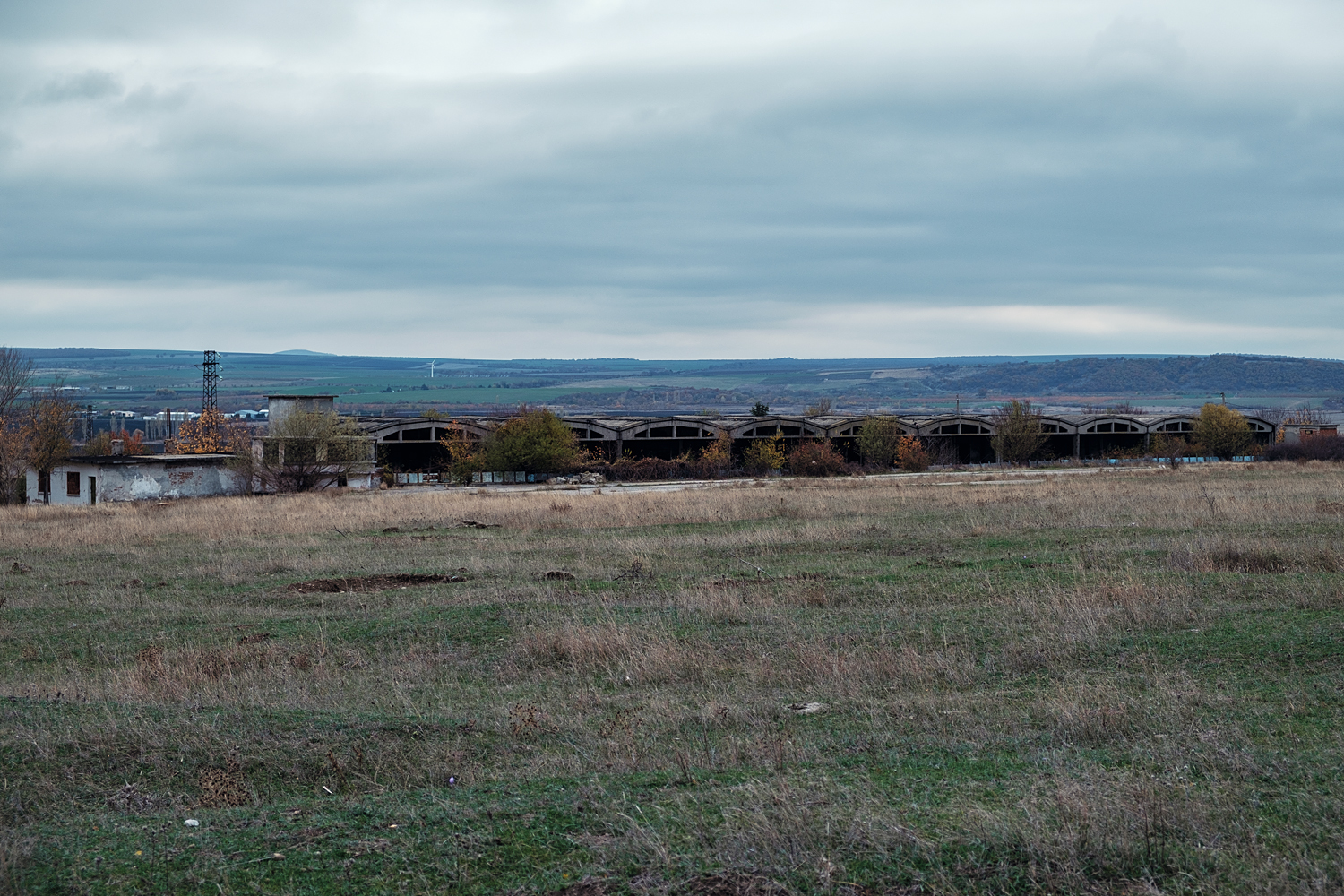 I was a bit anxious crossing the open field, but encountered no trouble and was soon in front of what seemed an observation post, right next to the tank garages:
I was a bit anxious crossing the open field, but encountered no trouble and was soon in front of what seemed an observation post, right next to the tank garages: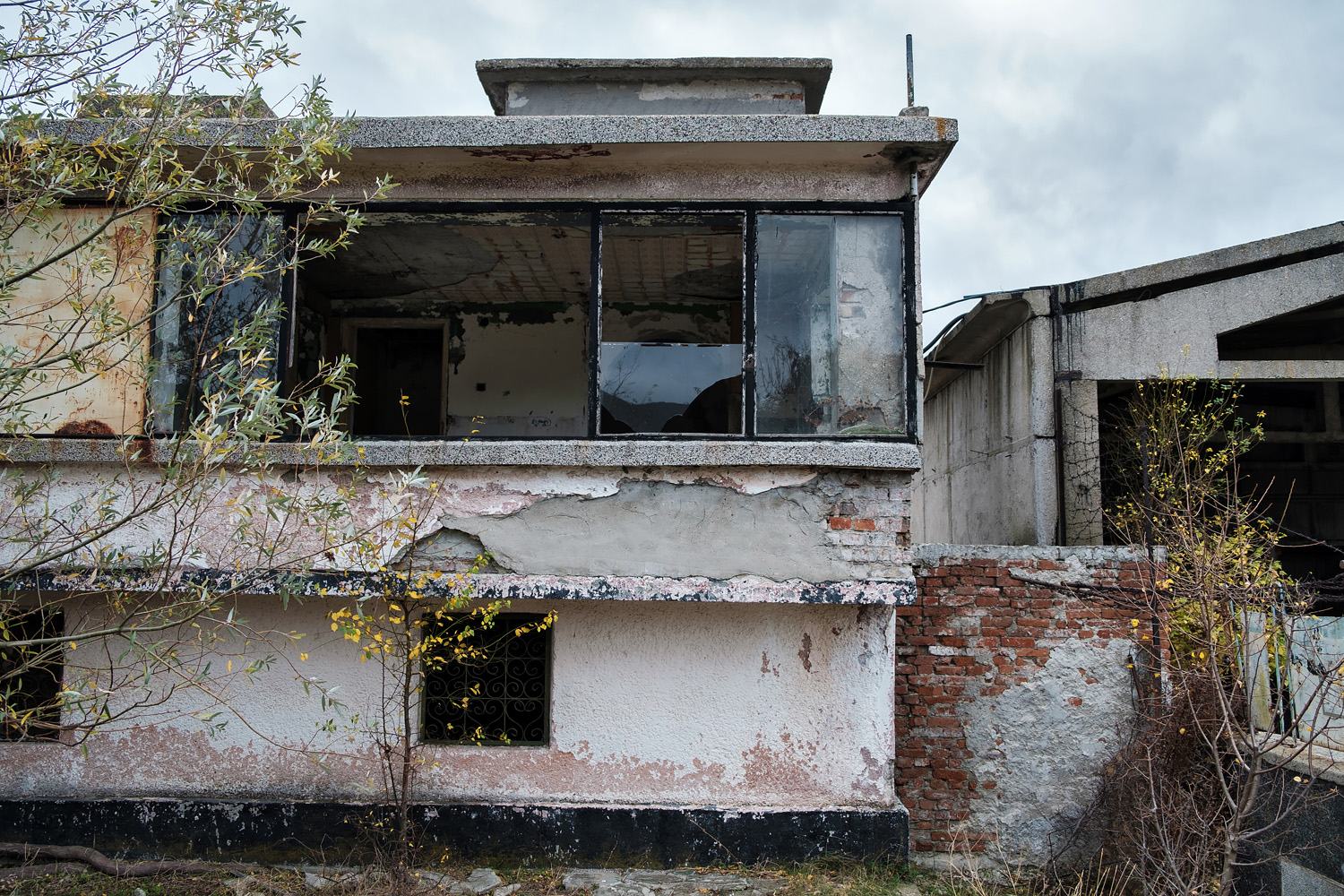 To my right - a faded and barely discernible slogan. It read: "United and undefeatable in peace and in the fight for defense of the deed of socialism"
To my right - a faded and barely discernible slogan. It read: "United and undefeatable in peace and in the fight for defense of the deed of socialism"  Past the blue fence, decaying tank garages lined the open space in direct defiance to the slogan's optimism:
Past the blue fence, decaying tank garages lined the open space in direct defiance to the slogan's optimism: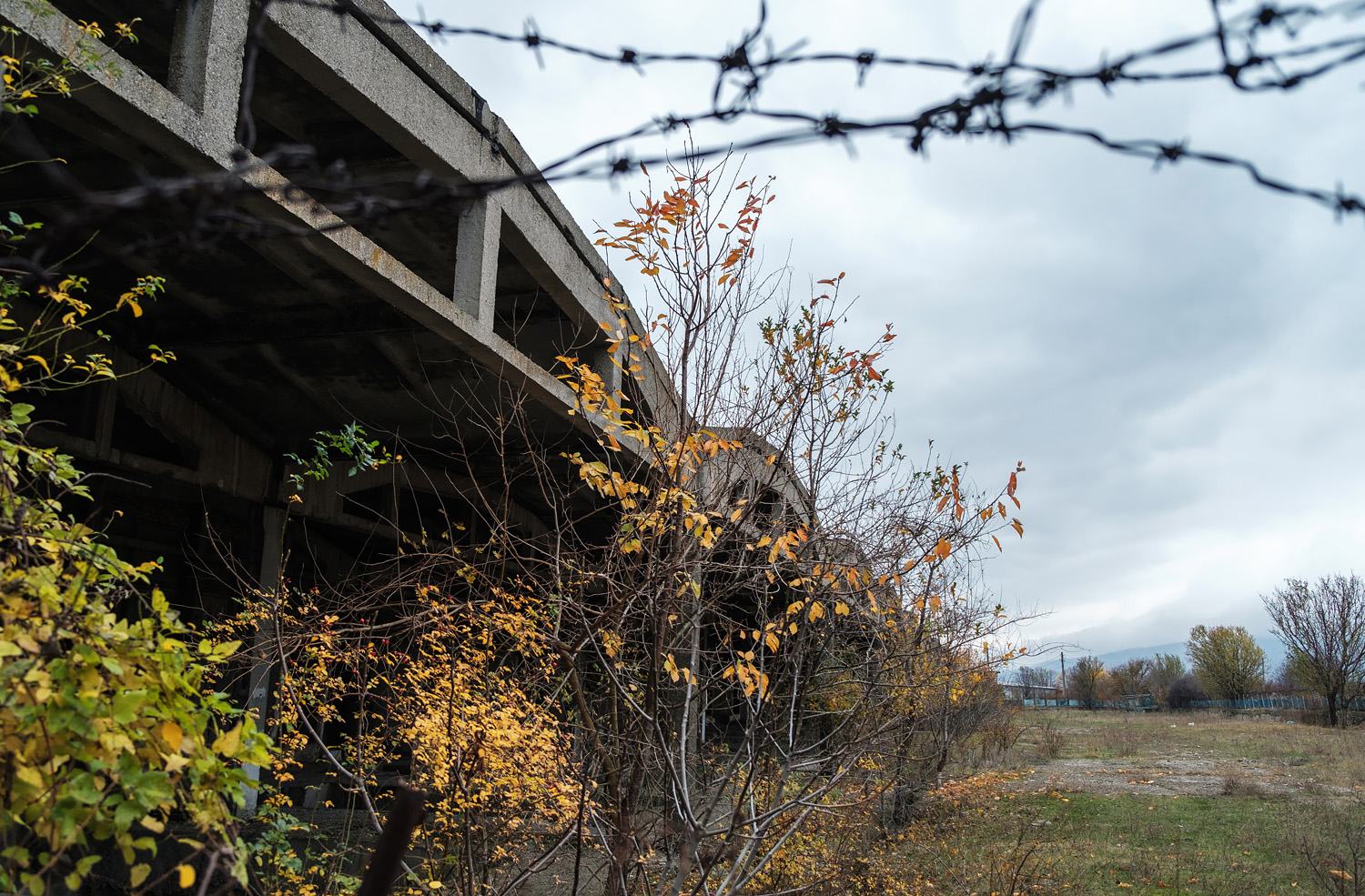 Another sign nearby denoted that I was now at the "beginning of post number 4":
Another sign nearby denoted that I was now at the "beginning of post number 4":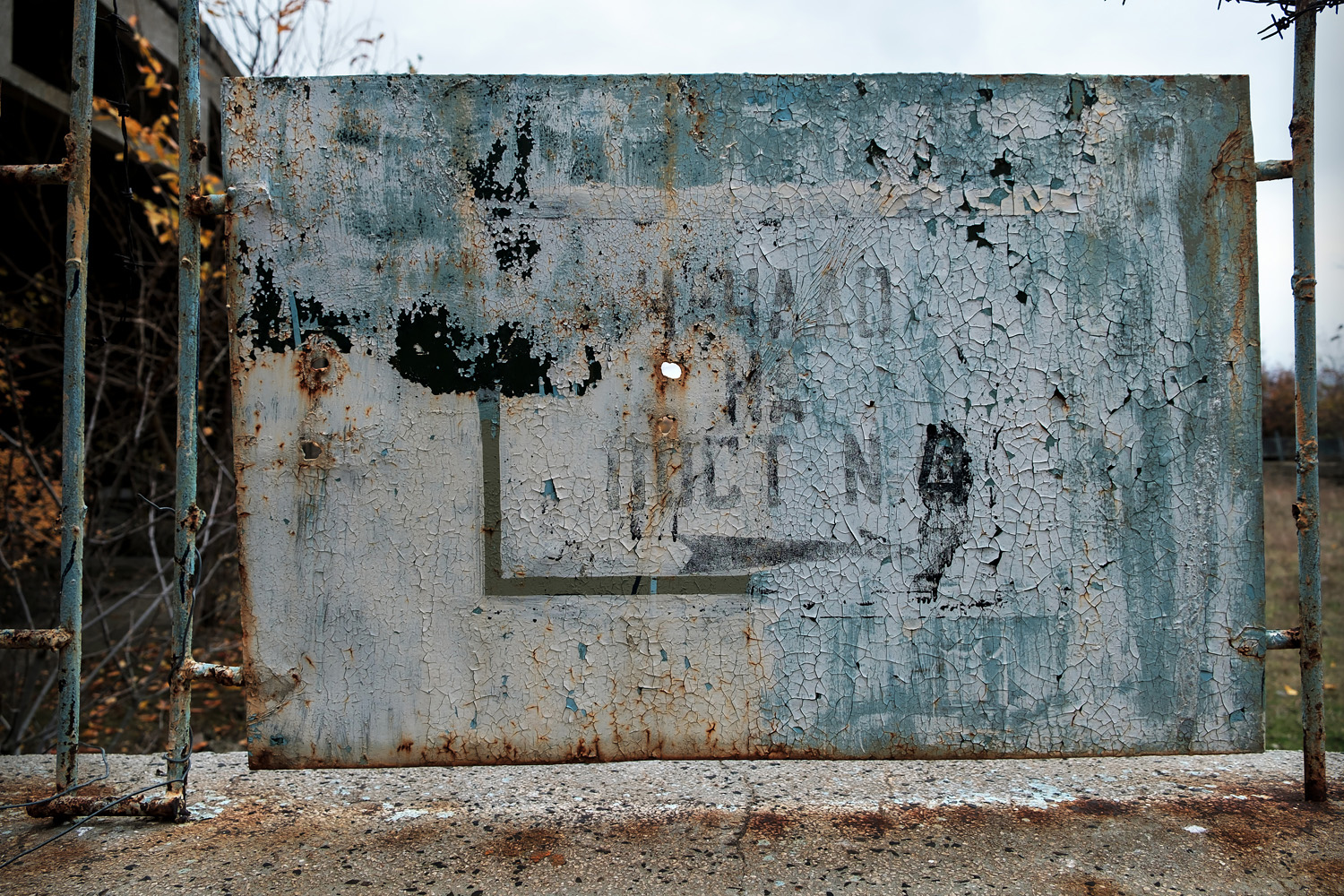 I decided to see if I can breach the meager defenses of the observation post and rounded the building cautiously, lest an unfriendly canine, or an unfriendly local emerge from the unknown. They did not, though signs that I was not the only visitor to these once-forbidden areas were plainly visible:
I decided to see if I can breach the meager defenses of the observation post and rounded the building cautiously, lest an unfriendly canine, or an unfriendly local emerge from the unknown. They did not, though signs that I was not the only visitor to these once-forbidden areas were plainly visible: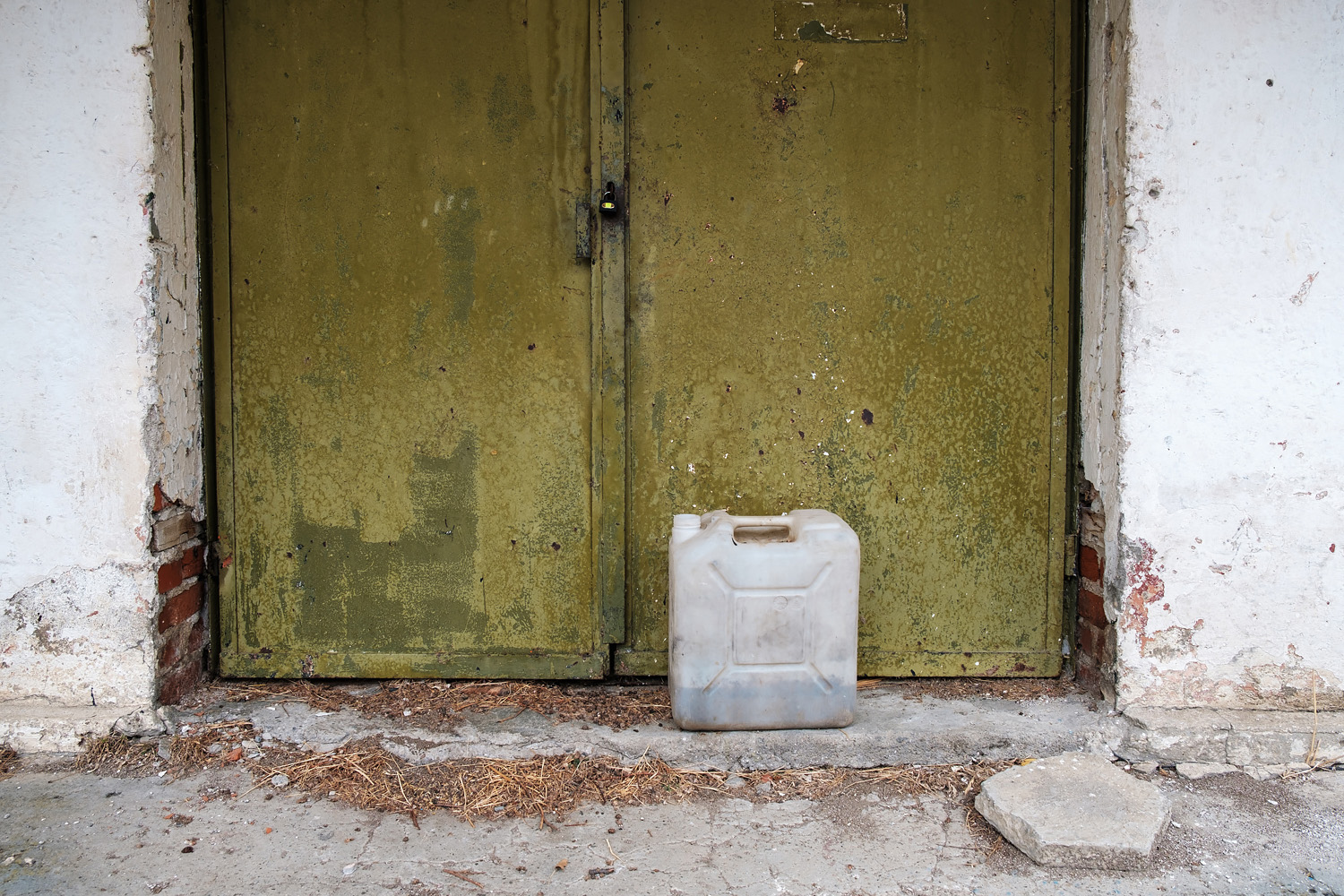
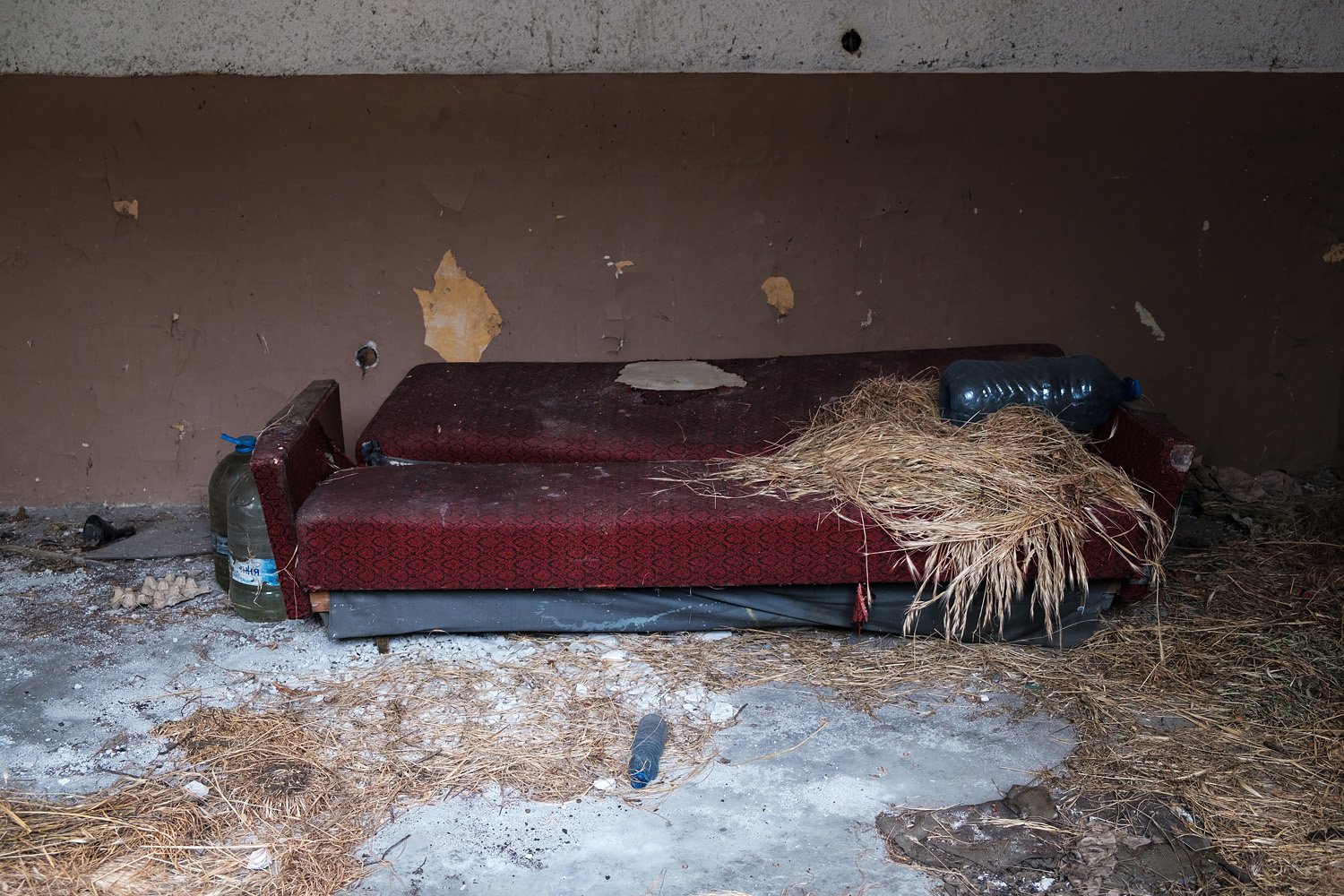 And a tribute to the city of Silistra was emblazoned upon a garage wall:
And a tribute to the city of Silistra was emblazoned upon a garage wall: 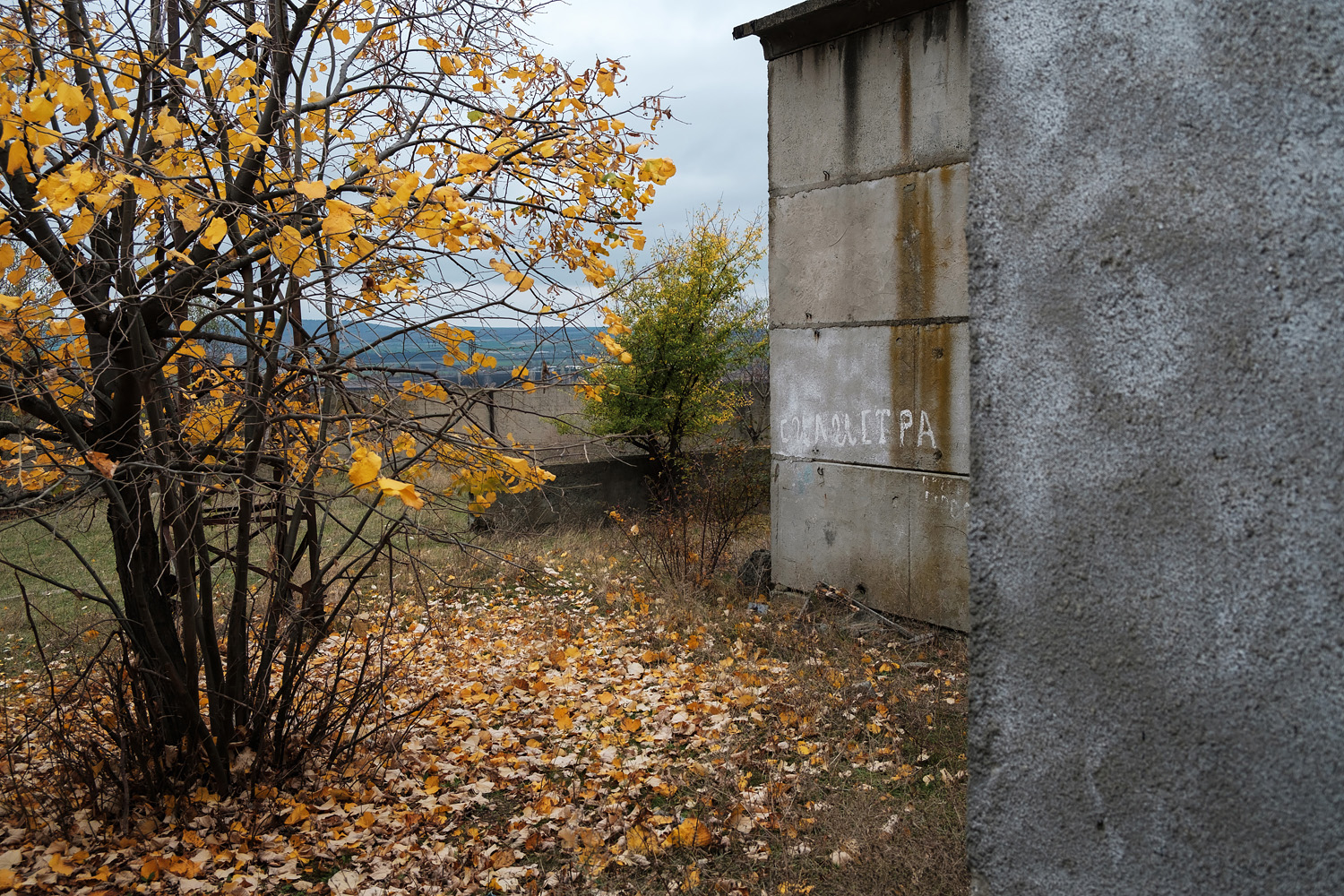 Up the short stairwell to see if the door would let me in, then. The decrepit sign roughly translates to "firing observation posts":
Up the short stairwell to see if the door would let me in, then. The decrepit sign roughly translates to "firing observation posts":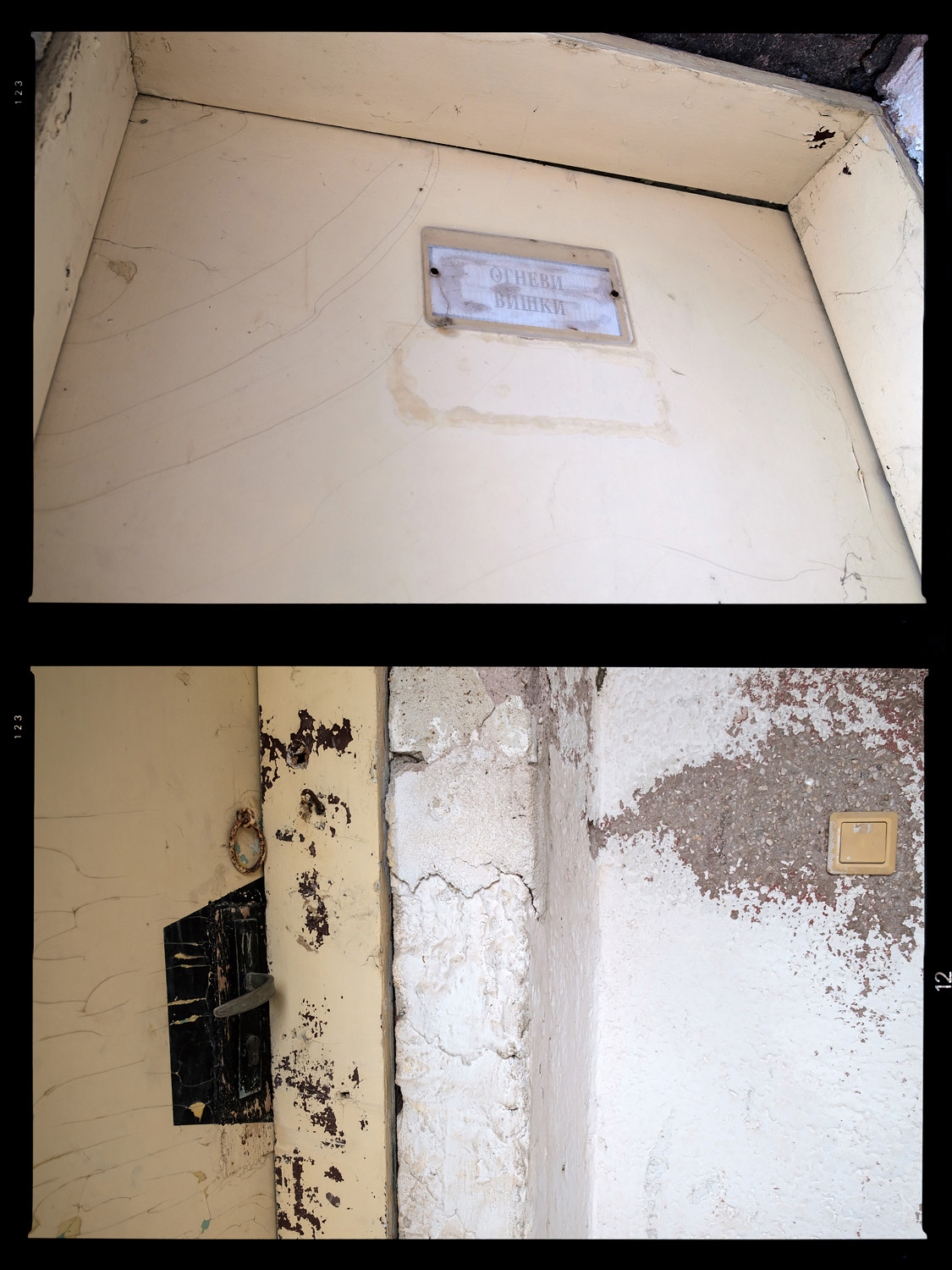 The door did give way without much protestation and I now laid eyes upon what military commanders once observed from this slightly elevated position:
The door did give way without much protestation and I now laid eyes upon what military commanders once observed from this slightly elevated position: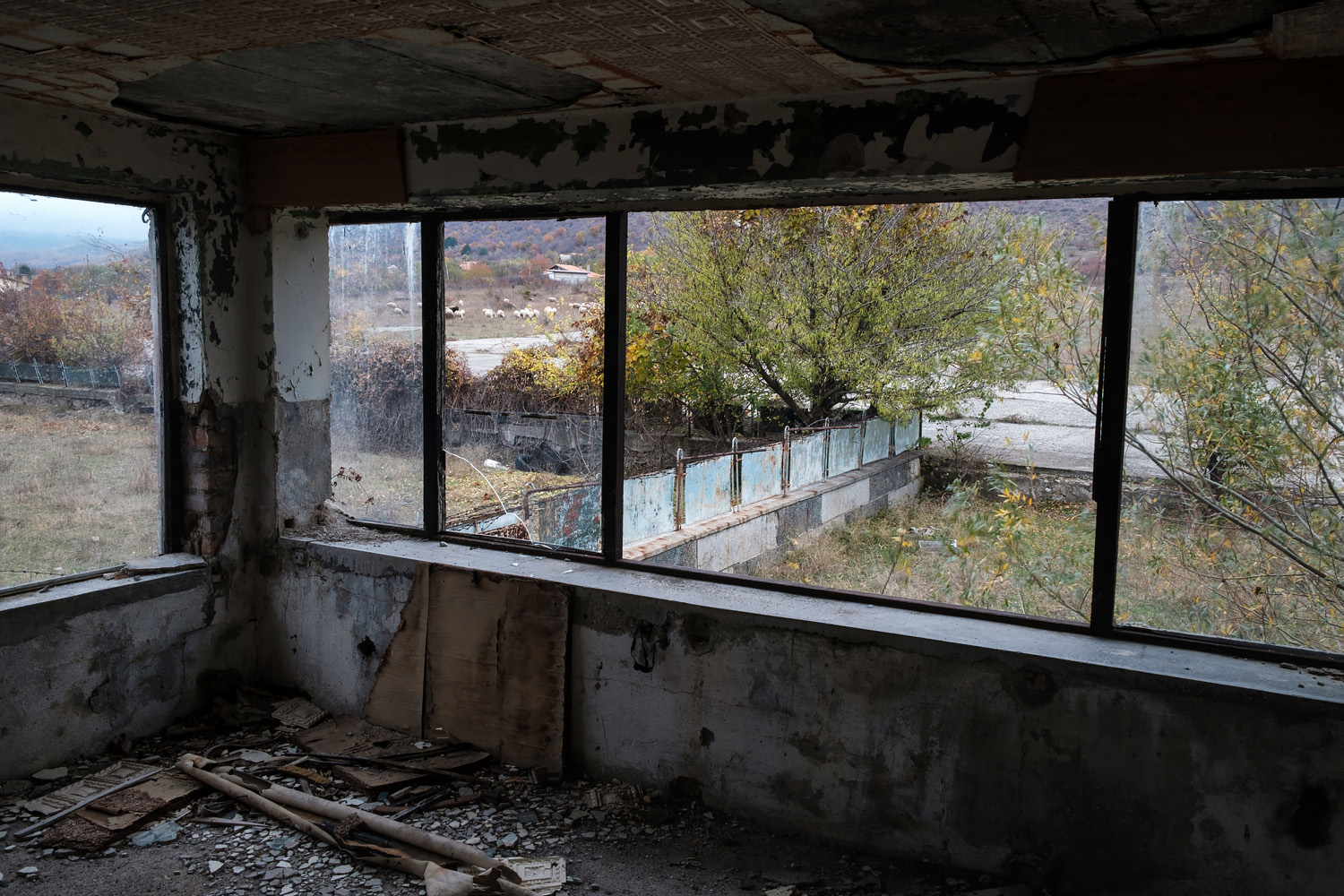
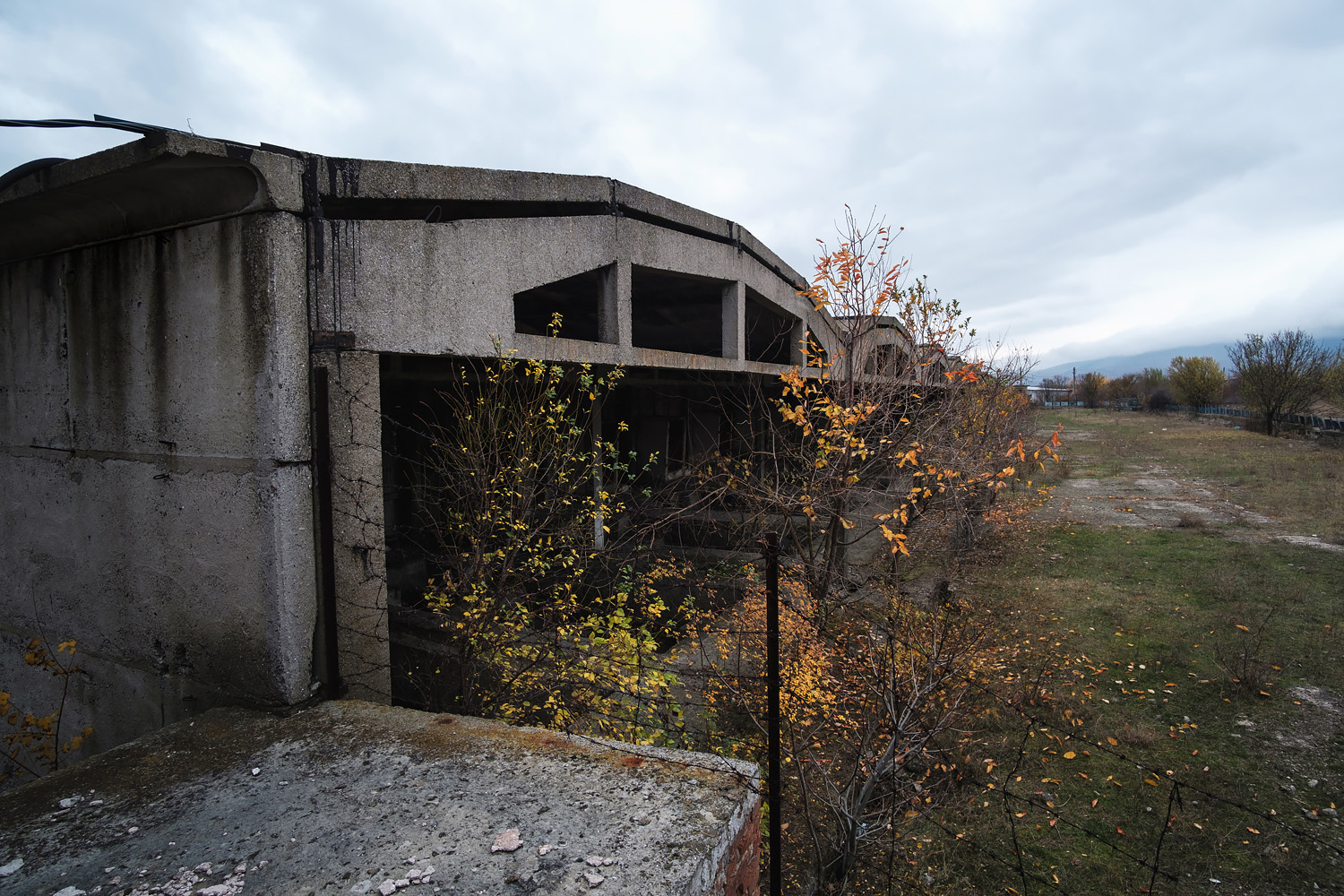 Sheep were grazing in the nearby field and the voice of the shepherd could clearly be heard from where I was standing. I was well camouflaged, however, and did not have any reason to expect any trouble anyway, since the sheep and shepherd were just as much trespassers as I was. But no one seemed to care. I looked around the room and found some interesting design details about. Remains of intricate plastic roof tiling:
Sheep were grazing in the nearby field and the voice of the shepherd could clearly be heard from where I was standing. I was well camouflaged, however, and did not have any reason to expect any trouble anyway, since the sheep and shepherd were just as much trespassers as I was. But no one seemed to care. I looked around the room and found some interesting design details about. Remains of intricate plastic roof tiling: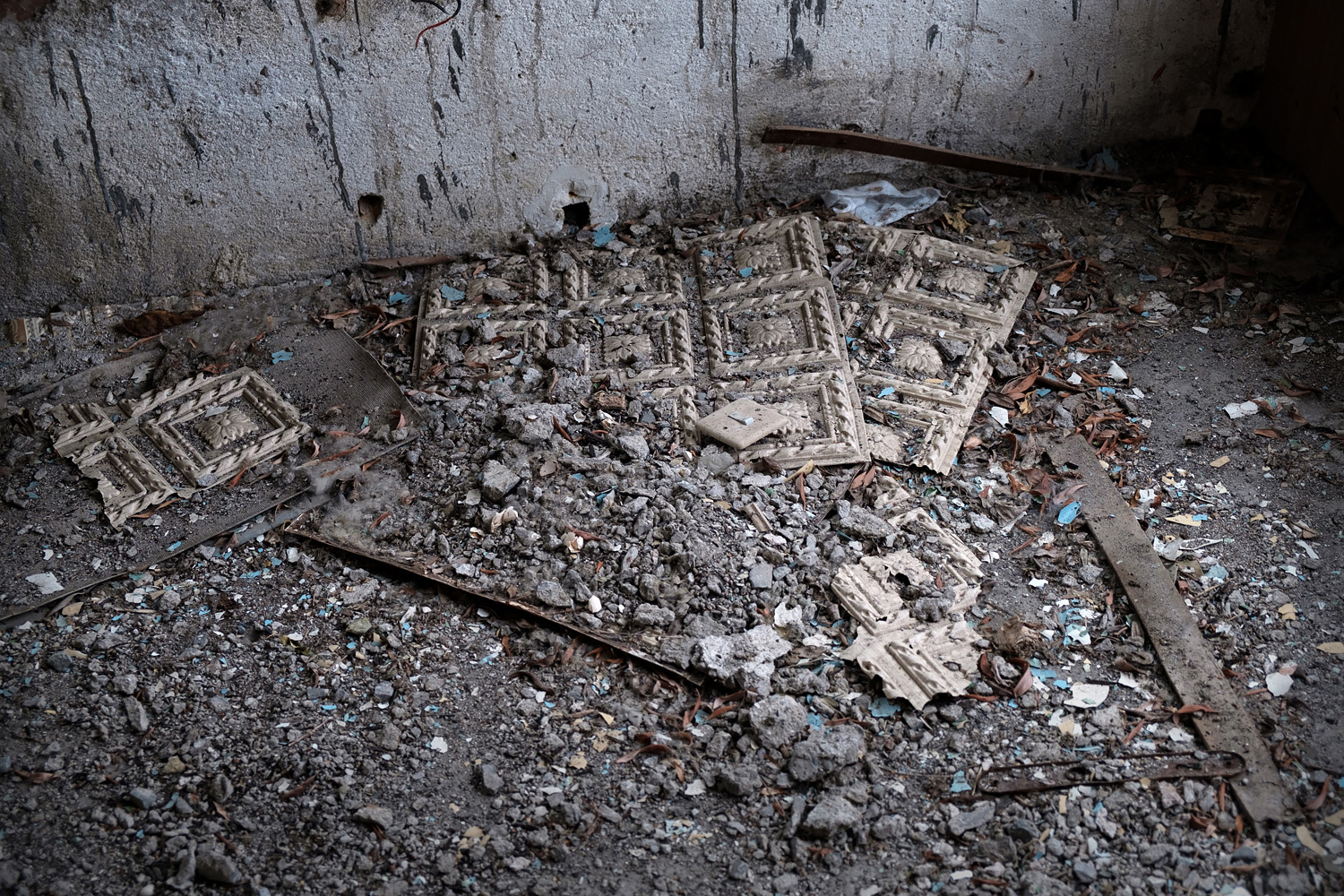 And a Mediterranean-looking arch, leading to a secondary, smaller compartment. Very much out of place in the spartan, cookie-cutter world of socialist military construction:
And a Mediterranean-looking arch, leading to a secondary, smaller compartment. Very much out of place in the spartan, cookie-cutter world of socialist military construction:
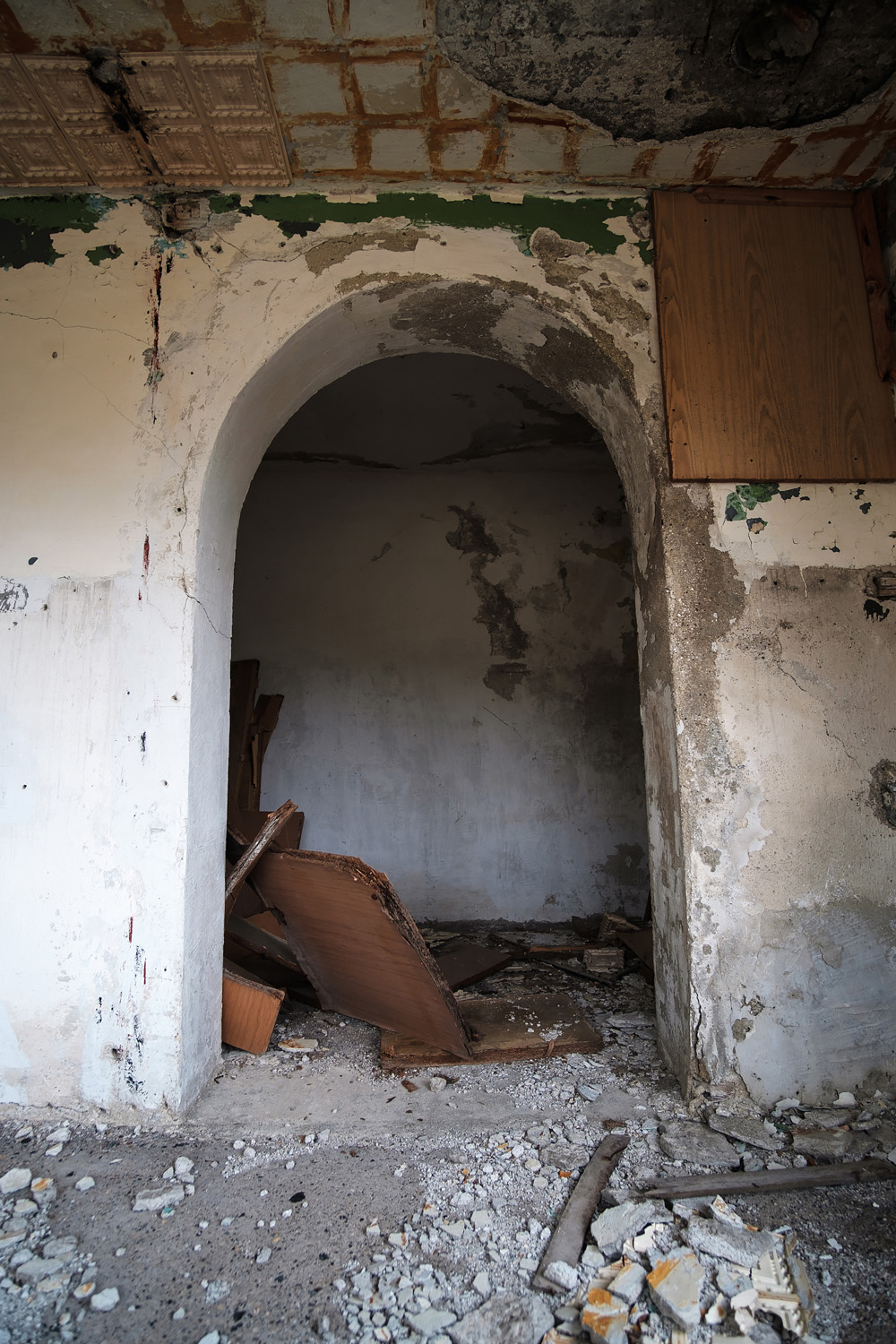 Further in, another observation room, quite like the first, and in an equally-advanced state of decomposition:
Further in, another observation room, quite like the first, and in an equally-advanced state of decomposition: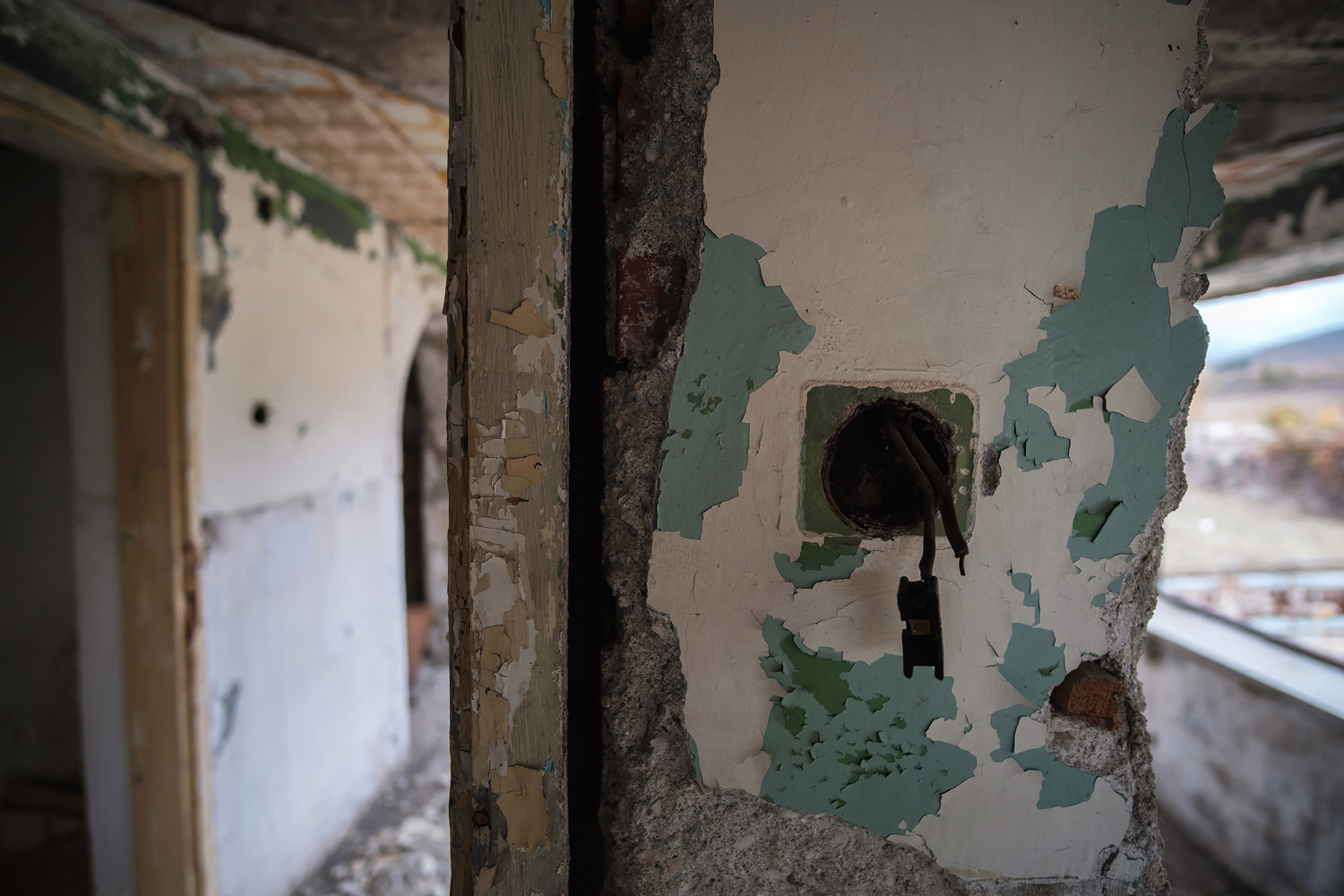
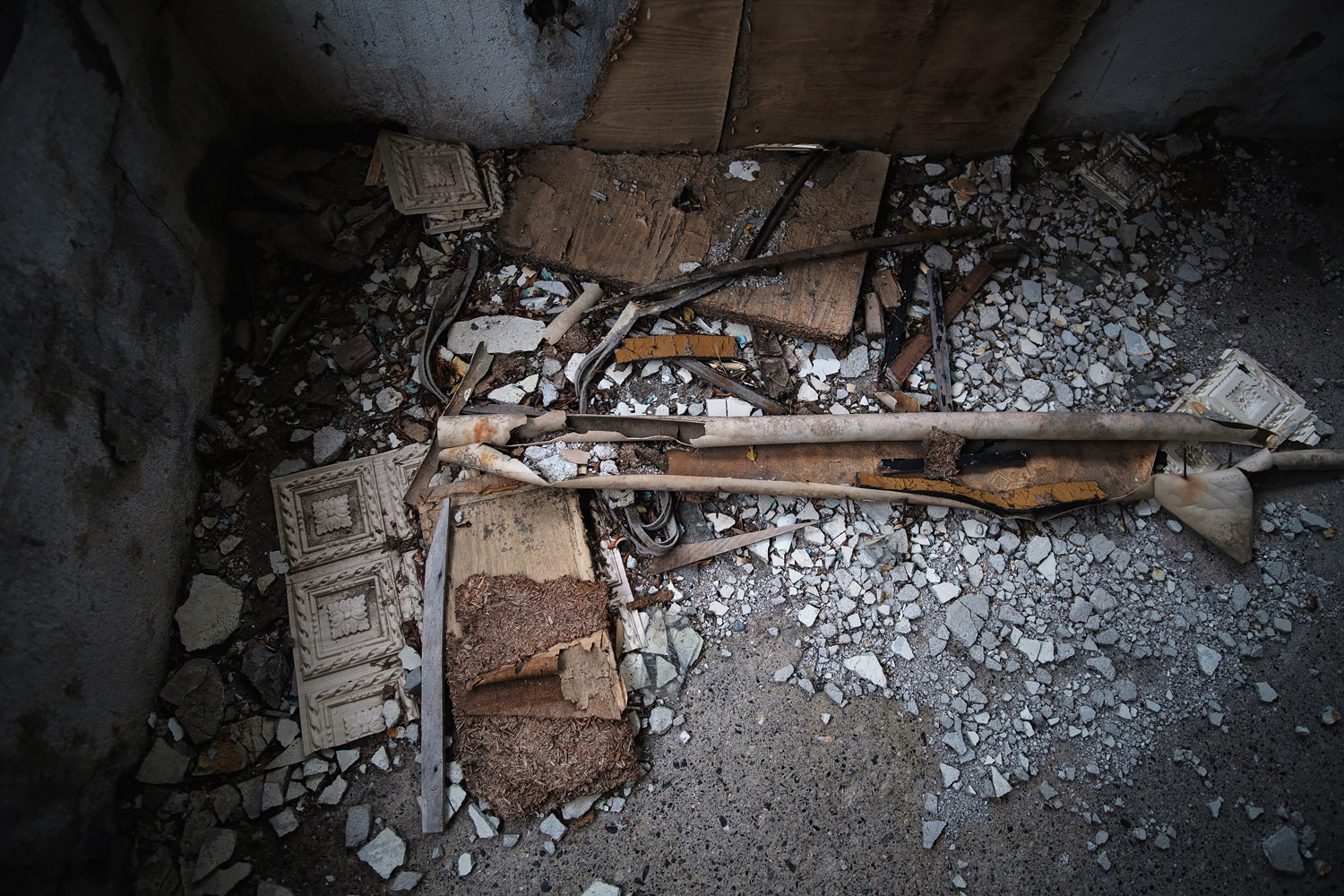 There was only so much to see here. I exited and headed down the stairs to see if anything else of interest lay behind the tank garages. I quickly came upon the usual graffiti, left over from soldiers that once served here:
There was only so much to see here. I exited and headed down the stairs to see if anything else of interest lay behind the tank garages. I quickly came upon the usual graffiti, left over from soldiers that once served here: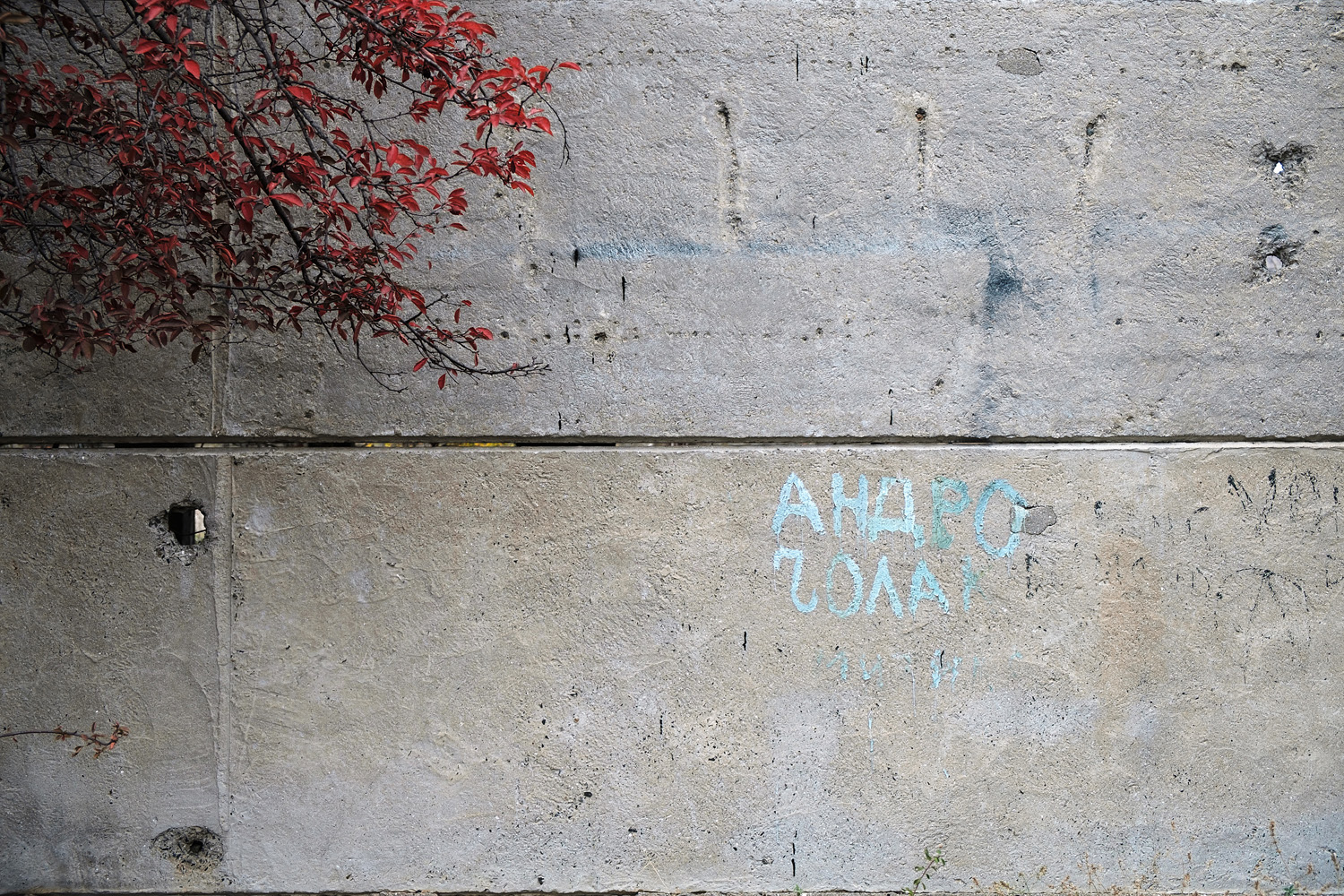 Through a gap in the wall I was soon able to get a good look at the inside of the tank garage compartments:
Through a gap in the wall I was soon able to get a good look at the inside of the tank garage compartments: 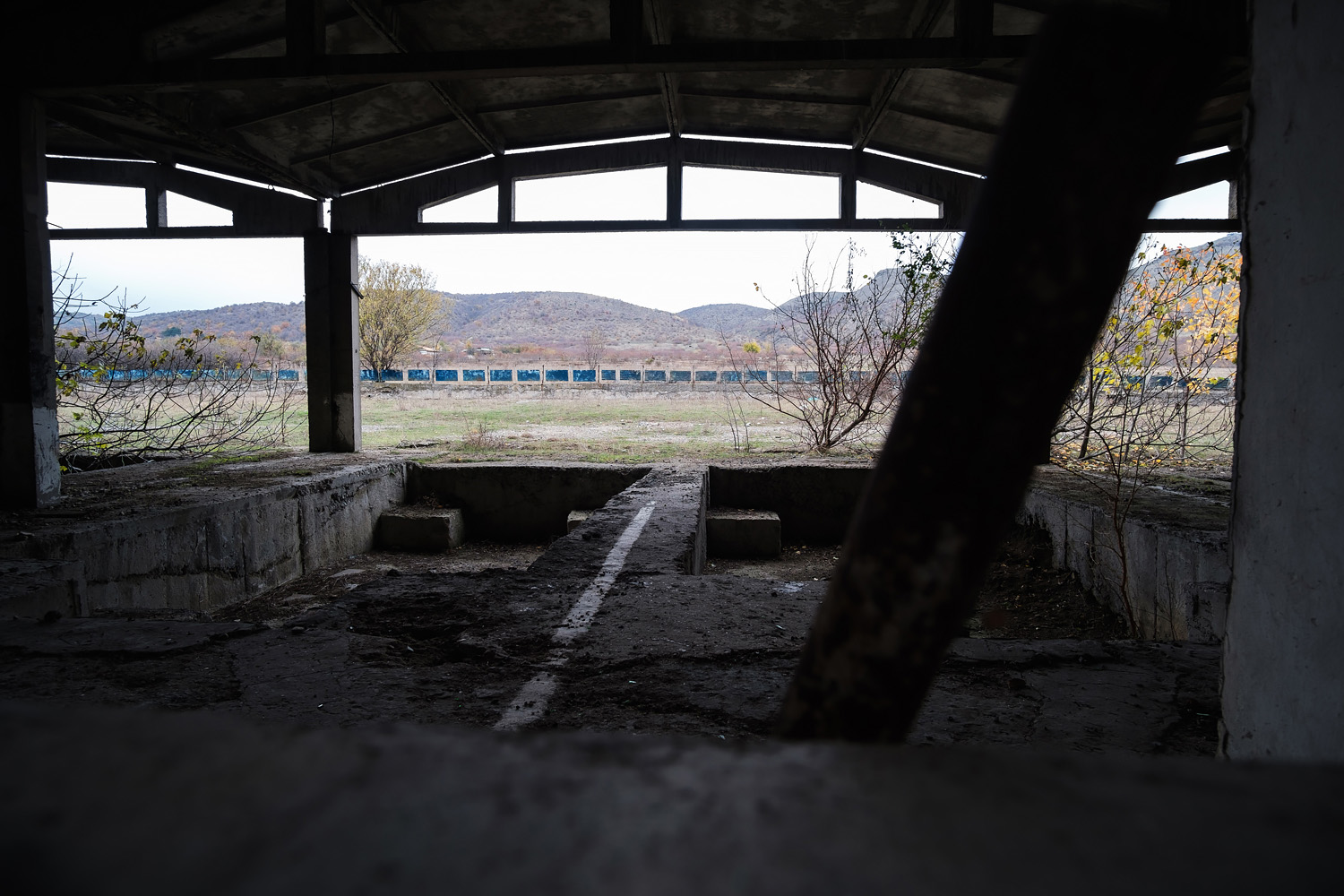 It was strangely peaceful in the old compound, forgotten by time and by man. I had hardly felt the advance of the day, but time been marching on and I had to return to the outside. I looked around for an exit strategy and soon found a gap in the once-solid stone-slab wall. The egress was made difficult by yet more overgrowth that had filled in the hole, but I managed to escape intact.
It was strangely peaceful in the old compound, forgotten by time and by man. I had hardly felt the advance of the day, but time been marching on and I had to return to the outside. I looked around for an exit strategy and soon found a gap in the once-solid stone-slab wall. The egress was made difficult by yet more overgrowth that had filled in the hole, but I managed to escape intact.
As I walked back to my car on the grassy shoulder next to the road, I caught a glimpse of the gates that used to keep intruders out of the very place I had so easily entered a few hours ago. The desolation and decay were total. I could not help but feel a little bit sad that this is what the proud military past of Aytos was now reduced to. But nevertheless, there it all was - an old ruined shell, in so many ways emblematic of the state of the city and the country in which it was now breathing its last. Time does not forgive and change is the only constant in life. Nowhere are those two clichéd yet painfully true dictums more clearly illustrated than in the military ruins of my home town.